
My senior year in high school, I took a junior college-level course about the philosophies of the world. Since it met only three times a week, and I had classes before and after, I would spend Tuesdays and Thursdays in the library. One of those days, I found a novel with Dustin Hoffman on the cover. Having seen The Graduate and Tootsie, I knew who Hoffman was, and I liked what I had seen, so I was intrigued. Also, having been a cross-country runner my first two years, as well as running track-and-field my freshman year, I admit I was intrigued by the title. That title was Marathon Man, by William Goldman, who died Friday at the age of 87. In his book The Season: A Candid Look at Broadway, Goldman describes becoming a fan of Willie Mays after seeing a spectacular catch he made in center field (as well as the throw he made immediately afterward), and “never wavering since”. Though I went on to disagree with Goldman on a lot of things, and disliked some of his work – which I’ll discuss below – I similarly have not wavered in being a fan of his since finding Marathon Man in the high school library that Tuesday or Thursday morning.
Goldman, of course, was probably best known as a screenwriter, one of the few members of that profession to attain status (barring those, like Preston Sturges, Billy Wilder, and the Coen Brothers, who either went on to direct their own scripts, or always served as writer/director on their films), winning two Oscars for screenwriting (Butch Cassidy and the Sundance Kid, an original, and All the President’s Men, adapted from the book by Carl Bernstein and Bob Woodward, though as I wrote in a previous post, how much of it he actually wrote has been disputed). and writing other films (The Princess Bride, based on his own novel) that have become classics. He was also known for what he wrote about Hollywood, particularly his famous saying, “Nobody knows anything”, from his seminal book Adventures in the Screen Trade, to illustrate that no one in Hollywood – not studio executive, director, producer, writer, star, and so on – knew what movies will work and what won’t. But it’s important to remember him as a novelist as well (and I’m not just saying that because that’s how I first knew of his work, though I had dimly remember reading an excerpt of Adventures in the Screen Trade in an old issue of American Film that my father had), not just because he started out that way (he had written five novels before he started his first screenplay, which I’ll also get to below), but also because he always considered himself a novelist first and a screenwriter second, even though his last novel (Brothers, a sequel to Marathon Man) was published in 1986.
Goldman’s first novel, The Temple of Gold (taken from his favorite film of all time, Gunga Din), is a coming-of-age story about Ray, a young man whose friendship with Zachary (nicknamed Zock) becomes a formative part of his life, especially when it turns to tragedy. In the book Which Lie Did I Tell? (a follow-up to Adventures in the Screen Trade), Goldman admitted he started writing out of revenge (he had an alcoholic father and a mother who was deaf (according to Goldman, she lied blamed him for going deaf, and only admitted the truth when she was dying), but though, as i hinted above, the story is not ultimately a happy one, it feels honest and earned. As would be a trademark in his novels, Goldman packed it with autobiographical details (like Ray, Goldman served in the Army, on a base instead of in combat), and while I am wary of the idea that a work being personal on the maker’s part automatically making it good, it certainly helped here. His second novel, Your Turn to Curtsy, My Turn to Bow – Goldman’s favorite book title of his own work – is his one love story, telling a tale of young love. Soldier in the Rain, inspired by Goldman’s time on an army base, is a tragicomic story of a friendship between Eustis and Maxwell, two soldiers on the base, and what happens to them when the base they’re on is going to close and Eustis tries to convince Maxwell, a lifer, they’ll be better off as civilians (it was made into a movie in 1964, directed by Ralph Nelson, with Steve McQueen as Eustis, Jackie Gleason as Maxwell, and co-starring Tuesday Weld, Tony Bill, and Adam West, but Goldman had no involvement; despite the performances, it’s more glib and less deeply felt than the novel). All three of the novels were short, and Goldman, who by that time had moved from his hometown of Chicago to New York City, decided to write a long novel, inspired by the fact many of his friends in New York were trying but failing.
The result, Boys and Girls Together (which is taken from a lyric in the song “The Sidewalks of New York”, by Charles B. Lawlor and James A. Blake – “Boys and girls together, me and Mamie Rorke/Tripped the lights fantastic on the sidewalks of New York”), was a sprawling and involving novel about several characters who come to the city and get involved in making of a play that one of them writes, one directs, and others appear in (as it happens, while writing the novel, Goldman and his brother James – The Lion in Winter – doctored a play, and wrote two other plays – Blood, Sweat & Stanley Poole and A Family Affair – that both flopped on Broadway). While it got mixed-to-bad reviews, Goldman received a huge advance sale, and it became a best-seller in paperback.
This was also the novel that inadvertently led to his movie career. At one point in the writing (it took several years), Goldman became blocked, and had no idea how to continue, only to one day come across a news story that speculated there might be two Boston Stranglers killing people (this was the big real-life crime story of the time), and as he put it, an entire novel dropped in his head. That novel eventually became No Way to Treat a Lady, which Goldman published under a pseudonym (Harry Longbaugh, the real name of the Sundance Kid), and wrote in an unusual format, with a lot of chapters (one as short as one word). Cliff Robertson, best known now for playing Uncle Ben in the 2002 Spiderman movie, but who at the time was a TV and Hollywood actor, read a galley of the novel, liked it (though he thought it was a film treatment rather than a novel, possibly because of its unusual format), and approached Goldman to adapt the Daniel Keyes story “Flowers for Algernon” for him to star in. While Goldman ended up getting fired from that project (which later became the movie Charly, and earned Robertson a Best Actor Oscar), Goldman was called in to work on the dialogue for Masquerade, a spy spoof directed by Basil Dearden (The League of Gentlemen, Victim) and starring Robertson, and became a screenwriter after that.
Though Goldman’s next screenplay, Harper (adapted from the Ross MacDonald novel The Moving Target, the first of his Lew Archer detective novels), starring Paul Newman, was a hit, it wasn’t until Butch Cassidy and the Sundance Kid that Goldman became a name in Hollywood. Goldman received a huge advance sale for the screenplay ($400,000), the movie, despite bad reviews (Richard Schickel, at the time, called it “The Wild Bunch for people who couldn’t stand The Wild Bunch” – a film Schickel loved – though Schickel would later reverse his opinion on Butch, and Pauline Kael called it “a facetious Western”, and “all posh and josh, without any redeeming energy”), became a big hit, and it was nominated for seven Oscars and won three, including a Best Original Screenplay award for Goldman. Parts of the movie don’t hold up very well – the Oscar-winning score by Burt Bacharach and theme “Raindrops Keep Falling On My Head” (performed by B.J. Thomas) feel awfully glib for a movie that’s supposed to be about people who, despite being “buddies”, don’t know each other as well as they think they do, and are behind the times in ways; in addition, some of the cinematography by Conrad Hall comes off as self-conscious, and Katherine Ross’ role as Etta, the woman shared by Butch (Newman) and Sundance (Robert Redford, in his breakout role), is ill-defined at best and problematic at worst. Still, it’s a good movie about male friendship, and in my opinion, it doesn’t get enough credit for the way it turns certain Western tropes on their head, with Butch, most of the time, getting by on his wits and charm rather than shooting a gun (it feels appropriate that Goldman’s only other Western penned for the screen – Mr. Horn was made for TV – Maverick, was also about a character who survived on his wits and charm, though unlike the TV character played by James Garner, Mel Gibson’s incarnation also knew how to handle a gun).
Despite the Oscar, and despite more screenplay work – more about that below – Goldman continued to occupy himself otherwise. His first non-fiction work, The Season (which he was able to write thanks to the advance sale for Butch), took a look at the 1967-68 Broadway season (probably best known today for James Rado and Gerome Ragni’s Hair, Neil Simon’s Plaza Suite and Tom Stoppard’s Rosencrantz and Guildenstern are Dead). While profiling all of the plays that opened on Broadway that year (as well as covering their early out-of-town tryouts in most, if not all, cases), Goldman also took on what he saw as the problems of Broadway at the time – the over-reliance on plays from abroad (particularly Britain) rather than trying to cultivate homegrown talent, the shoddy business practices, and the way Broadway, in general, avoided contemporary concerns, or treated those concerns superficially. Again, parts of this don’t hold up well – his attack on critics (he calls them putrescent in general) is, to say the least, overblown, his chapter on “critics’ darlings (which he described as actresses who let their tics do their acting for them) is pretty sexist, and while his chapter on homosexuals in the theater is well-meaning (he wanted more plays like The Boys in the Band – which had recently opened off-Broadway – where homosexuals could write honestly about their experiences and feelings instead of having to “code” their work) it comes off as problematic. Still, much of it still rings true today, and comes off less as a diatribe than as a fan who wants Broadway to right itself.
Goldman also continued to write novels. The Thing of It Is…, about a songwriter who hates the song that’s become a hit, and who is forced to confront his failing marriage and his Jewish identity (Goldman was inspired to write this after a trip to Europe where he himself confronted his own Jewish identity after visiting a Jewish ghetto in Venice). While No Way to Treat a Lady had been adapted into a film (with Harper director Jack Smight as director, and starring Rod Steiger and George Segal) without his involvement, Goldman was involved in two unsuccessful attempts to film The Thing of it Is…, one with Elliot Gould (after Goldman’s original choice, Redford, backed out) and Dyan Cannon (which ended when director Mark Rydell – who replaced Ulu Grossbard after he backed out – insisted on bringing in another writer and Goldman insisted on getting paid, which torpedoed the project), and the other with director Stanley Donen and producer Robert Evans, which ended when Evans vetoed the male lead choices (James Caan and Alan Alda) and Ali McGraw, who originally wanted the female lead, did The Getaway instead. Goldman did write a sequel to the novel, Father’s Day (about the main character’s relationship with his daughter), and planned to turn the story into a trilogy (with The Settle for Less Club being the proposed title of the third and final entry), but that never happened. Instead, Goldman ended up writing what became his most beloved work, and, along with Butch, his favorite of his own work, The Princess Bride.
As much as I like the movie version of The Princess Bride – it was my fourth favorite film of 1987 – I love the novel even more. Originally inspired by stories he had told his daughters, Jenny and Susanna (one wanted a story about princesses, while the other wanted a story about brides), Goldman, after getting writer’s block, decided to pretend he was “abridging” a long-lost masterwork by S. Morgenstern, which Goldman claimed his father would read to him (Goldman continued the joke years later with another Morgenstern “story”, The Silent Gondoliers), but which, despite having a good story of “true love and high adventure”, as the tagline put it, turned out to be “unreadable” because of chapters dealing with material “irrelevant” to the tale of “true love and high adventure”. Though you could use this as another example of Goldman not writing women particularly well – the title character, well-played in the film by Robin Wright in her film debut, is still a bit of a cipher – it manages the difficult task of sending up adventure stories and love stories while also being a brilliant example of both. And while it ends on a more hopeful note than Goldman’s other work – if still ambiguous (the movie is more sunny) – it still goes into Goldman’s usual dark places, including one character’s difficult relationship with their father, not to mention the torture of the hero.
It was around this time Goldman’s editor since Soldier in the Rain, Hiram Haydn, died (in an introduction to a later edition of Marathon Man, Goldman calls him a father figure), that Goldman’s novels became more genre and more commercial. Marathon Man, which is about a grad student in history who becomes the target of an ex-Nazi, was a thriller. Magic, with a plot similar to a segment of the anthology film Dead of Night (a ventriloquist is suffering from a split personality and is also a murderer), is a horror novel, Tinsel, about a producer planning to make a film about Marilyn Monroe’s final days, and the three women desperate to play the part, was of course a Hollywood novel. Control, which brought together a disparate group of characters and a plot to kill Alexander Graham Bell, was science fiction. Heat (not to be confused with the Michael Mann film) was a combination of a crime novel and an action story, and Brothers was a sequel to Marathon Man. Only The Color of Light was of a piece with his earlier, literary work, about a writer struggling with his life and his writing. Still, even though he may have gone in a different direction in his writing, Goldman still, at his best, writing characters that you could get emotionally involved in, as well as stories that you could get involved in as well. For example, Marathon Man – which, along with The Princess Bride and The Color of Light, is my favorite of his novels – has both Babe, that grad student in history, and Doc, his brother (unbeknownst to Babe, Doc is a lot more than he seems) both affected by the suicide of their father, a former professor who lost his job during the McCarthy era, and killed himself because of that. It was also a novel where Goldman inserted a lot of his tastes in what he liked of movies (Babe takes his girlfriend to a double bill of movies directed by Ingmar Bergman, Goldman’s favorite filmmaker), sports (Scylla, an assassin, manages to overcome someone trying to kill him by using a move he saw Earl Monroe pull on Walt Frazier once on the basketball court) and wine (Doc bores Babe in talking about wine, but also uses his knowledge to soften up Babe’s girlfriend Elsa before he interrogates her about her real motives), among other things.
Brothers turned out to be Goldman’s last novel (though he had planned a sequel to The Princess Bride, called Buttercup’s Baby, it never panned out). By that time, he had written Adventures in the Screen Trade, which, 35 years later, still remains the best book ever written about Hollywood. Of course, it is known today for his famous line “Nobody knows anything”, which demonstrated that while people in Hollywood knew what worked in the past, they did not, could not, and would not, know what would work in the future (as an example, Raiders of the Lost Ark, the first team-up of George Lucas and Steven Spielberg, was turned down by every studio except for Paramount). But it’s a lot more than that. Though I don’t share Goldman’s contempt for directors (he wrote they are not artists and get too much credit for the films they do) or stars (he wrote they were too often concerned with how to make the material work for them, rather than how to make the material work), he, along with Pauline Kael, were my major influences in being skeptical of the auteur theory (ironic, since Goldman was not a fan of Kael’s, and vice versa), and giving me awareness of how movies were often based on accommodating the stars, and not to the benefit of the movie. As I am pre-disposed to not see studio executives in a good light, I think Goldman is often too easy on them, perhaps due to his close relationship to some of them, but he does point out how the executives’ reluctance to believe the story is the real star of a film has led to some questionable decisions, to say the least. I also think there are good movies that are more character-driven than story-driven – and often prefer the former – but Goldman’s insistence that “screenplays are structure” (which he meant as his other big theme of the book, along with “nobody knows anything”) is a useful guide. Goldman was also honest about his own failings, included perspectives from other people involved in making a film (in a section where he asks such people as cinematographer Gordon Willis, editor Dede Allen, and composer David Gruisin about hypothetically adapting one of Goldman’s short stories, “Da Vinci”, to the screen), and gave insight about the craft and the process of making a film.
More importantly, Goldman’s book taught me to respect screenwriters and screenwriting, and to shy away from the easy assumption often made by most critics that if a film doesn’t work, it’s always the screenwriter’s fault (even though it is pointing out the script is the most important part of the film). Though he disparaged any idea of screenwriting being an art, and insisted it was just a craft (albeit an important one), Goldman’s book was an important influence for me in viewing screenwriting as an art (along with Richard Corliss’ book Talking Pictures). So it’s sort of sadly ironic that while I revere Goldman as a fiction writer as well as a non-fiction writer – in addition to The Season and Adventures, he also co-wrote (with sportswriter/novelist Mike Lupica) a great book about a year in the life of New York sports teams (Wait Till Next Year), and he wrote an entertaining book about the year he was a judge at both the Cannes Film Festival and the Miss America contest (Hype & Glory), and I liked his follow-up to Adventures (Which Lie Did I Tell?) even if I disagreed with some of it (I don’t share his contempt for Saving Private Ryan, for example) – I am not necessarily a fan of many of the movies where he’s listed as screenwriter.
Of the films in which he’s credited on, only All the President’s Men and The Princess Bride are films I like without reservations. I’ve mentioned my slight reservations about Butch Cassidy and the Sundance Kid; I also like, with reservations, Harper, The Hot Rock, The Great Waldo Pepper, Marathon Man, Maverick, and Absolute Power. The Stepford Wives didn’t work for me (though given the fact I have not been a fan of Bryan Forbes’ previous work, that’s where the fault may lie, especially with Goldman’s assertions that Forbes re-wrote much of the film), nor did A Bridge Too Far (I don’t agree with Francois Truffaut’s assertion that there’s no such thing as a truly anti-war film, but if I did, this film would be the first one I’d present as evidence), Magic (though, admittedly, it’s a tough novel to adapt), Misery (the novel scared the shit out of me, and unfortunately, the movie didn’t), Year of the Comet (I don’t dislike this as much as critics and audiences at the time, did, but it’s too arch to be the light entertainment it wants to be), The Chamber (though, admittedly, the source material wasn’t great either), The Ghost and the Darkness (as with Year of the Comet, I didn’t hate this, but while the lion sequences are scary, the humans aren’t as interesting), The General’s Daughter (a thoroughly detestable movie, though since Goldman’s not the only credited writer, and Simon West is a hack director, it’s hard to know who to blame), and two more Stephen King adaptations, Hearts in Atlantis and Dreamcatcher (admittedly, not a fan of either source).* As with his novels, Goldman has a good ear for dialogue, and he puts his personal obsessions into the movies in interesting ways (even in Hearts of Atlantis, one of his less successful movies, there’s a nice scene where the main character, played by Anthony Hopkins, reminisces about seeing Bronko Nagurski during the game he came out of retirement, which Goldman actually saw), but the emotions and characters he brings to life in his novels do not come to life in the movies he’s written or co-written.
Still, this should not diminish Goldman’s accomplishments. In an age when writers and creativity continue to be devalued, he has consistently advocated the idea writers and their work should be treated with respect, not the contempt they so often are. While he was often disparaging about his own work as a writer, he wrote two of my favorite movies of all time, three of my favorite novels of all time, and the arguably the most important book about Hollywood ever written. That’s a good enough legacy for anyone.
*-Memoirs of an Invisible Man and Chaplin I didn’t include, even though he’s credited on both, because on the former, while he was the original writer, he was re-written after he quit and a new director came on board, while on the latter, he was one of many writers as well.
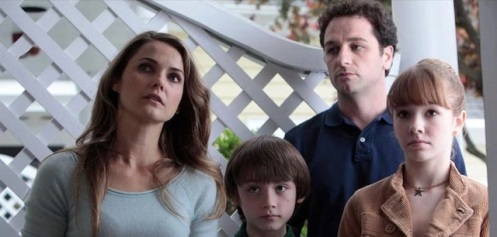
In his book Making Movies, Sidney Lumet wrote about how, when he decided to direct a film (he rarely wrote it, so he was almost always directing someone else’s work), he always asked himself, “What is this movie about?” Not the story, but the theme of the movie, or what grabbed him about it, whether the theme was underlying or right up front. One theme Lumet tackled a couple of times, in films as varied as Daniel, Running on Empty, and Family Business, was, as he put it, “Who pays for the passions and commitments of the parents?” This theme ended up being a major underlying theme of The Americans, which ended its six season run this past Wednesday.
Of course, it wasn’t the only theme of the series. Show creator Joe Weisberg (an ex-CIA agent and novelist) and co-executive producer Joel Fields (a veteran TV producer) were revisiting the Cold War, and avoiding the glow of nostalgia to portray a time more complicated than many remember it to be. The series was also a portrait of a marriage, with Elizabeth (Keri Russell) and Philip Jennings (Matthew Rhys) having to be partners not only at home, as well as their “respectable” business (they owned a travel agency), but also their real work, as Soviet spies undercover near Washington D.C. And just as the show avoided easy answers in looking at the Cold War and the Jennings’ marriage, it also tackled the 80’s in a way that avoided the kitsch of most stories looking back at that decade. However, as with other shows with anti-heroes (from our point of view, anyway) at their center, The Americans also showed the toll spying took on the Jennings’ children, Paige (Holly Taylor) and Henry (Keidrich Sellati).
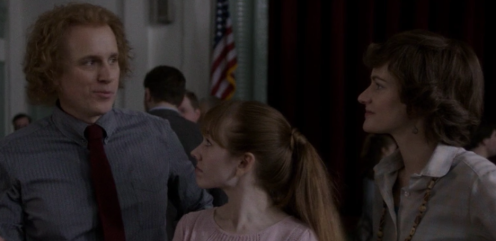
When the series first began, Paige and Henry seemed like your normal kids from a stereotypical nuclear family. Paige was interested in her studies, while Henry was interested in sports and games. Both, as they grew older, became interested in the opposite sex; Paige with Matthew (Danny Flaherty), the son of Stan Beeman (Noah Emmerich), the FBI agent who was the Jennings’ neighbor, while Henry never had anything steady, though he did become infatuated with one of his teachers, as well as Stan’s then-wife Sandra (Susan Misner). But as the series progressed, you could see Paige and Henry react to their parents’ unconventional lives (no relatives, no friends outside of Stan, being out at all times, and often until late hours). For Henry, this manifested itself in the way we’re used to seeing kids who have been neglected by their parents on-screen – playing on his computer or with video games, fooling around with himself, and finding another parent figure (in this case, Stan). Paige’s situation, however, was much more complicated.
At the end of Season 1, after Elizabeth and Philip escaped capture (though not without Elizabeth getting shot), Paige took a look inside the laundry room where her parents often conducted business or had private conversations, and while she didn’t find anything incriminating (Elizabeth and Philip were too good at their jobs for that), her curiosity, and suspicion, were piqued. At first, except for a furtive visit early in Season 2 for the “Aunt Helen” Elizabeth had supposedly been recuperating with, her reaction didn’t come out in obvious ways. Most teenagers engage in some form of rebellion, but Paige’s method of rebellion was unusual; she got religion. She joined a church, became friends with Pastor Tim (Kelly AuCoin), the head of the church, and became an active participant. Elizabeth and Philip, being the product of a country that saw religion as the opiate of the masses, were less than thrilled, even though, ironically, Paige was, through the church, participating in things Elizabeth professed to believe in, such as protests in favor of nuclear disarmament. At first, all of the arguments involving Paige centered on her religious beliefs. However, in the season 2 finale, “Echo”, Claudia (Margo Martindale), one of Elizabeth and Philip’s handlers, revealed to them the Centre wanted Paige, and eventually Henry, to join the family business and become spies. For the majority of Season 3, Elizabeth and Philip quarreled over this plan – Elizabeth was for it, somewhat, while Philip was adamantly against it – until Paige forced their hand.
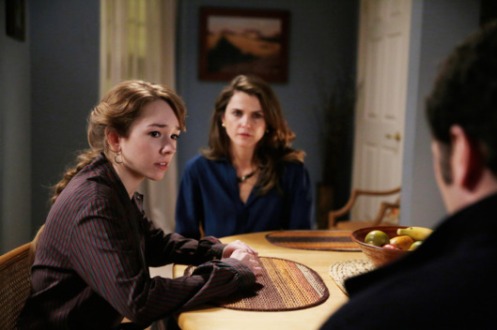
In the episode “Stingers” – my vote for the best episode of the series – after Elizabeth and Philip returned from one of their missions one night, Paige confronted them in the kitchen, and demanded to know what they were really up to. Ironically, it was Philip who indicated he and Elizabeth should answer this question, and while they didn’t tell her everything, they did admit to Paige they worked for the Soviet Union (Elizabeth had been laying the groundwork by talking about the things she believed in, that she thought Paige would appreciate). Paige’s first reaction, was shock, and even a little outrage. And while many fans were upset about her subsequent action, I was not; she called Pastor Tim and told him all she knew. This, of course, put Elizabeth and Philip’s lives at risk – both of them were outraged when they found out, and Paige was apologetic – but while Pastor Tim and his wife were understandably nervous around Elizabeth and Philip (especially after Pastor Tim goes missing in the Season 4 episode “Munchkins” during a trip to Africa, though he was eventually found), and he encouraged Paige to come forward with what she knew at first, eventually, he decided not to betray the Jennings family (though in his diary, he does describe Elizabeth and Philip as monstrous, and eventually takes a job in Buenos Aires to get away from the situation at the end of Season 5).
More interestingly, Paige found herself eventually becoming a spy, or at least acting like one. At first, she was just, reluctantly, keeping tabs on Pastor Tim and his wife (after Elizabeth ordered her to in no uncertain terms), and being secretive from others (which is why she eventually broke things off with Matthew, because she couldn’t stand keeping the truth from him). But gradually, Paige became drawn into her parents’ world, partially to learn to take care of herself (after she witnessed Elizabeth dispense of a mugger in the episode “Dinner for Seven”), though mostly because she was becoming somewhat intrigued by her parents’ world, and perhaps had deluded herself into believing what Elizabeth was telling her, that they were ultimately doing “good” work, even though she kept expressing doubts. And in Season 6, Paige was actually working directly for Elizabeth with spying (at the end of Season 5, Elizabeth told Philip he should quit spying, and he agreed). It was only simple stuff – following someone by car or on foot, staking out a location, and even adorning simple disguises (not as elaborate as the wigs Elizabeth and Philip wore) – but Paige did get into the work, as well as meeting with Claudia and Elizabeth to talk about life in the Soviet Union, and even offering to get close to a Senate intern (which Elizabeth vetoed, though Paige ended up sleeping with him anyway). Paige is even able to defend herself against two boys who try to attack her in a bar (in “The Great Patriotic War”). Elizabeth, though, had admitted to Philip Paige might not be cut out for spying, and told Paige (in “Harvest”) to apply to work for the State Department as an intern.

However, in “Jennings, Elizabeth”, the next-to-last episode of the series, Paige accuses Elizabeth of seducing another Senate intern, and when Elizabeth unconvincingly denies it, Paige calls her mother a whore. Elizabeth tells her off in turn, saying how privileged she is compared to what Elizabeth grew up with. Unfortunately, events soon force their hand. Philip, who has reluctantly come back to the fold, is meeting up with a priest whose superior has just betrayed the priest to the FBI (as Stan has suddenly become suspicious of the Jennings family), and Philip is barely able to escape and make a coded call to Elizabeth to basically tell them they need to flee. Philip and Elizabeth meet at a safe house after Elizabeth has packed what they need, and that’s when the series takes an unexpected turn. Henry has at boarding school, pursuing both his interest in math and hockey (early in the season, we see Philip cheering him on at a game), though Philip had worried he wasn’t going to be able to keep paying for it, especially after his travel agency business starts to go south. But it seems like Henry has made a life for himself outside of the family (made clear in the episode “Rififi”, when Henry comes home for Thanksgiving, only for Elizabeth and then Philip having to go on a mission), and Philip tells a shocked Elizabeth in the series finale (“START”) they have to let him go.
Elizabeth and Philip do end up taking Paige – reluctantly on Paige’s part, as she’s still angry at her mother, until she finds out what’s going on – and after the three of them manage to talk their way out of a confrontation with Stan (who has been staking out Paige’s apartment building), they make their escape. After making one stop to call Henry on a pay phone to say goodbye without actually saying goodbye (Paige is too overcome with emotion to say anything), they take a train to Canada so they can fly back to the Soviet Union, which is when we get our final shock. At the border, without telling anyone, Paige gets off the train, leaving both Elizabeth and Philip in shock, though they continue to the Soviet Union. In short, everyone gets separated in an uncertain future – Elizabeth and Philip in Moscow, Henry still at school (though knowing now the truth, after Stan visits and tells him), and Paige on her own (she goes back to Claudia’s safe house, which is now empty, and downs a shot of vodka).
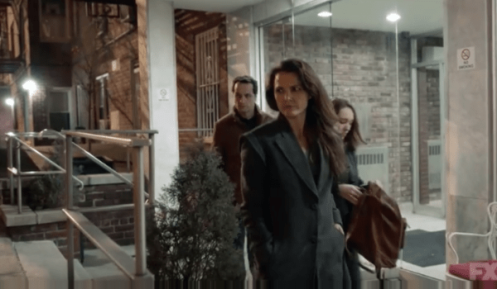
Some have complained the show essentially let the Jennings family off the hook by letting them escape. But consider their family has broken up – as much as Elizabeth put her country above everything, she still cared for her children, and Philip as well – and both Paige and Henry face uncertain futures (they both have school, but there’s a question of who’s going to pay for it, not to mention the suspicion they’ll be under). And that’s not even mentioning the fact we know what the characters don’t – the Cold War (at least in that form) will end in a couple of years (the last season of the show took place in 1987), and Elizabeth and Philip’s “cause” will be very different (and will they get to back and visit Paige and Henry? Who knows?). The Americans was a show about espionage. It was a show about people who believed they were doing the right thing, and doing horrible things to continue to do that right thing. It was a show about a partnership. But it was also show about a family. All of which (except for the espionage part) is the template of the show that was considered the game-changing show of the last 20 years or so, The Sopranos, and The Americans was the series that, in my opinion, did the best of following the template of a show about a family whose patriarch (or matriarch, or both) did horrible things in the name of what they thought was the right thing. But even more than The Sopranos, The Americans showed how the children paid for the commitments of the parents.
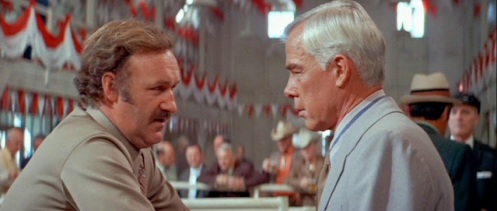
Gene Hackman and Lee Marvin in Prime Cut (1972).
As much as I’m a fan of the major acclaimed American movies of the late 1960’s and early 1970’s – as well as the foreign language movies that came out during that time – I can understand why some people may roll their eyes at yet another tribute to them. It’s not just the fact this was almost exclusively a province of Great White Males, with not much room for women or minorities (mistreated both in front of and behind the camera). Its also the fact people who sing the praises of these movies can sound as obnoxious about them as baby boomers who claim theirs was the “greatest generation” (as well as theirs being the only one that really protested anything), or as fatuous as the film professor in Andrew Bergman’s great comedy The Freshman (he’s brilliantly played in the movie by Paul Benedict) when he’s lecturing students about The Godfather Part II (which happens to be my favorite movie of all time). Finally, while movies like the first two Godfather films, Nashville and Taxi Driver may have been the ones that had critics then and now wax rhapsodic about the movies, as well as the people who made them (Coppola, Altman, Scorsese, and others) and the actors who appeared in them (Pacino, Nicholson, De Niro and others), with some exceptions (the first Godfather), these weren’t the big hits of the 70’s. Instead, they were blockbusters like Love Story, The Poseidon Adventure, The Exorcist, and The Towering Inferno.
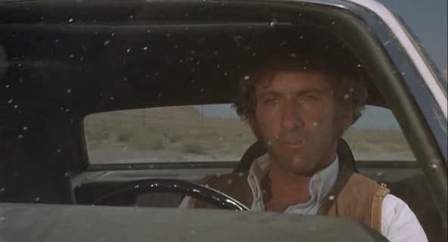
Barry Newman in his GTO in Vanishing Point (1971).
But what about the “B” movies, or genre movies, of the time? There have been books written about some of the specific genres of the time – horror movies, blaxploitation movies, westerns, and so on – but what Charles Taylor’s Opening Wednesday at a Theater or Drive-In Near You: The Shadow Cinema of the American 70’s aims to do is give an overview of those types of movies, ones that are among his favorites and ones that, for the most part, aren’t as well remembered (and, in some cases, aren’t even available on DVD, Blu-Ray, or streaming). Taylor was a fan of those acclaimed 70’s movies, so he’s not out to debunk those (though he is out to debunk another type of movie; see below), but to illustrate the pleasures these lesser-known films offer.

Kris Kristofferson and Gene Hackman in Cisco Pike (1972).
Opening Wednesday covers a broad range of genres, including crime movies (Aloha, Bobby and Rose, Born to Win, Prime Cut), car movies (Citizens Band, Two-Lane Blacktop, Vanishing Point), blaxploitation movies (while the chapter on these is devoted to Coffy and Foxy Brown, Taylor also writes about the genre in general), period dramas (American Hot Wax – which has as much comedy as drama – and Hard Times), westerns (Ulzana’s Raid), horror/thriller (The Eyes of Laura Mars), conspiracy thrillers (Winter Kills), cop movies (Hickey and Boggs), and revenge dramas (Bring Me the Head of Alfredo Garcia). Blaxploitation movies were exclusive to the 70’s (almost all the attempts to revive the genre have been satiric, such as Black Dynamite and I’m Gonna Git You, Sucka!), as were conspiracy thrillers for the most part (though there have been occasional attempts to revive it), and car movies, and westerns were starting to wane (until being revived in the 90’s with the one-two punch of Dances with Wolves and Unforgiven; they’ve gone hot and cold since then, on TV (Deadwood) and in movies (The Assassination of Jesse James by the Coward Robert Ford)). The other genres are still around, though only horror/thriller movies seems to be made as much as they were in the 70’s.
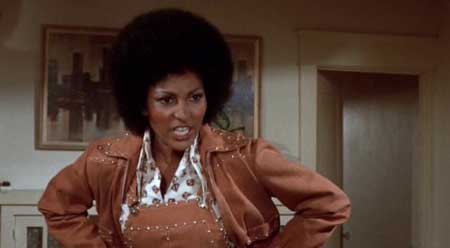
Pam Grier in Foxy Brown (1974).
Taylor is also spotlighting lesser-known directors of the time with this book. Robert Aldrich (Ulzana’s Raid) was beloved by auteur critics at the time, but while he had a couple of successes in the 70’s (The Longest Yard), his career was winding down. Likewise, while Sam Peckinpah (Bring Me the Head of Alfredo Garcia), who was equally loved and reviled in critical services, had success in the late 60’s/early 70’s (The Wild Bunch, Straw Dogs), alcoholism and too many battles with studio executives had taken their toll. Monte Hellman (Two-Lane Blacktop) has continued to make movies, but he has remained a cult figure, just as he started out in the 60’s. Though Jack Hill (Coffy and Foxy Brown) has become a cult figure thanks to a revived interest in blaxploitation films (as well as big-name fans like Quentin Tarantino), he made only a couple of more films after those. Both Bill Norton (Cisco Pike) and Floyd Mutrux (Aloha, Bobby and Rose, American Hot Wax) moved into television. William Richert (Winter Kills) ultimately has acted in more films than he’s directed, and while he worked somewhat steadily as a director in the 70’s and 80’s (though to decreasing returns), Richard C. Sarafian (Vanishing Point) became known more for his acting as well. Hickey & Boggs remains the only film actor Robert Culp ever directed. Only Jonathan Demme (Citizens Band), Walter Hill (Hard Times), Irvin Kershner (Eyes of Laura Mars) and Michael Richie (Prime Cut) enjoyed any major success in the 80’s and/or beyond. Though Demme did struggle in the 80’s, he directed cult hits such as Stop Making Sense and Something Wild, and made the Oscar-winning film The Silence of the Lambs, Hill has worked steadily and made such hits as The Warriors and 48 Hours, though Kershner, who started out in the 60’s, only made a few films in the 80’s, one was Sean Connery’s last James Bond film (Never Say Never Again, and one was a little film called The Empire Strikes Back, and Richie made The Bad News Bears and Fletch, among other films.

Pam Grier in Coffy (1973)
A devotee of Pauline Kael (he thanks her in the acknowledgments at the end, calling her the reason he wanted to become a critic), Taylor does analyze the films he reviews, but like Kael, he primarily wants to communicate the visceral part of the movie, to make you understand how it *feels*. This, for example, is from the opening paragraph of his essay on Two-Lane Blacktop:
“…we’re in a small-town service station North Carolina service station at what appears to be about six A.M. on a rainy Sunday morning. Maybe it’s Saturday. The characters themselves aren’t sure. These hot-rodders have pulled into the station to attend to a busted carburetor and it’s just as well the place is closed. The mood of this drizzling dawn seeps into everything. Pretty soon they’ve drifted away from the task at hand to nip at a bottle, doze, wander the town. One or two people are visible on the street but something in the still, quiet air makes it feel like nothing’s about to change. Saturday mornings in town give the promise of the bustle to come. Sunday never shakes off its sleepiness.”
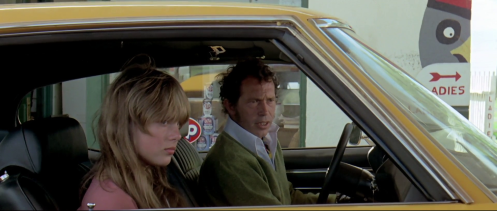
Warren Oates and Laurie Bird in Two-Lane Blacktop (1971).
As you might be able to guess from that excerpt, Taylor is also trying to stress the fact these movies are also showing a corner of the U.S. that doesn’t often get shown; not just the North Carolina as described above, but the Kansas City of Prime Cut, the Depression-era New Orleans of Hard Times, and the small Southern town of Citizens Band (though he does look at movies that take place in familiar cities, like the New York City of Eyes of Laura Mars, and movies that travel to multiple places, like Winter Kills). He also explores how many of these films communicate with film history, or their context in it, particularly in the works of three filmmakers he singles out: Preston Sturges (whom Taylor calls “the greatest American comic filmmaker of the sound era”), Howard Hawks (the “great modernist” whose films were about “communities of…drifters who coalesce around some task or purpose”), and John Ford (whose classic Stagecoach is about “the essential tension of American life, the desire to belong and the desire to light out for the territories”).

Burt Lancaster in Ulzana’s Raid (1972).
Taylor sees, for example, the comic sensibility of Sturges in Citizens Band – particularly in the subplot of a trucker (Charles Napier, a Demme regular) who happens to be married to two different women (Marcia Rodd and Ann Wedgeworth), and who both come into town (unaware of the other) to check up on him after he gets into an accident. But there’s also a Hawks-like spirit to the movie as well, particularly when the hero, Spider (Paul Le Mat, who also plays the lead in Aloha, Bobby and Rose) organizes other CB enthusiasts to help look for his missing father (Roberts Blossom). And you can see Ford in Hard Times (Hill, a classicist director, is a devotee of Ford and Hawks) in how people on the dregs, like the hero (Charles Bronson), an aging boxer, and his loudmouthed manager (James Coburn), look out for each other (even if Coburn inadvertently gets over his head). And while Sturges may not have gone as far as Winter Kills (based on the novel by Richard Condon) – in which the conspiracy theories of John F. Kennedy’s assassination get dropped through the proverbial rabbit hole to create a warped black comedy – he certainly would have recognized its comic spirit. Taylor also shows how some filmmakers have quoted from those movies, Quentin Tarantino in particular (Jackie Brown is one long love letter to the Pam Grier of Coffy and Foxy Brown, and the second half of Death Proof references Vanishing Point).

A doo-wop group rehearsing in American Hot Wax (1978).
Taylor’s primary purpose for the book, however, is to demonstrate how these movies, according to him, differ from the genre movies made today. Not only does he argue their stories are told more coherently than today’s blockbusters – even stories as outlandish as Eyes of Laura Mars (a serial killer movie where fashion photographer Faye Dunaway somehow sees through the eyes of the killer when he’s committing his murders), Winter Kills (see above) or Bring Me the Head of Alfredo Garcia (a revenge tale the way only Peckinpah could have made it) – but more importantly, that they stay connected to the world we live in more than the blockbusters and genre movies of today. The first example comes in the introduction with a movie that isn’t covered in the book, but was one of the inspirations for it; Jonathan Kaplan’s White Line Fever, about a Vietnam vet (Jan-Michael Vincent) who battles corruption in the trucking industry. I’ve not seen the film (though, like Taylor, I’ve enjoyed some of Kaplan’s other movies, like Over the Edge – still one of the best teen movies ever made – and The Accused), but apparently, it has things like Vincent and his wife (Kay Lenz) eating spaghetti for days on end because they can’t afford anything else, or Lenz wearing the only expensive dress she owns to court when she wants to help Vincent out of trouble, or Lenz confessing to her brother she might have to get an abortion. Taylor brings up other movies in the book with details like that, such as a waitress telling Charles Bronson in Hard Times that he only gets one refill for a nickel cup of coffee, or the sadness in Roscoe Lee Browne’s eyes in Cisco Pike when he refuses to buy Kris Kristofferson’s guitar (Browne owns a music shop), even though he knows Kristofferson’s claims he’s going back into the music business aren’t going to amount to anything, or how, in American Hot Wax, Alan Freed’s (Tim McIntire) days when he’s not being a DJ are basically meetings, meetings and more meetings.
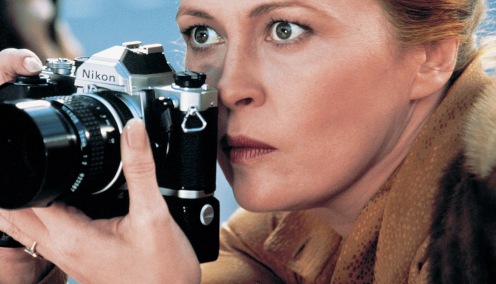
Faye Dunaway in The Eyes of Laura Mars (1978).
In trying to make his case, Taylor does fall into the trap that has befallen a certain strain of critics, who lay the blame of the blockbuster era on Star Wars. I have never been the fan of George Lucas’ saga that friends and family have, and I certainly agree with the criticism that Lucas seems to feel any indication, or mention, of sex would complicate his characters, and his stories, too much for him and for much of its audience. That said, blaming everything on Star Wars (as well as on Spielberg, another frequent target of the “Yesterday Was Better” club) is, I feel, pretty short-sighted. First of all, not to put a fine point on it, but Alfred Hitchcock’s Psycho did what Lucas and Spielberg have long been accused of – dressing up a B-movie plot with A-movie actors and storytelling – and has inspired more rip-offs than Lucas and Spielberg have, yet you don’t get a million think-pieces saying how Hitchcock and Psycho ruined movies. Secondly, as I pointed out before, this ignores the fact blockbusters were still making much more money than the critical faves of the 70’s, and Lucas’ (and Spielberg’s) films were better than most of those films (I’d rather watch Star Wars again than sit through one minute of The Towering Inferno, or The Exorcist, again).
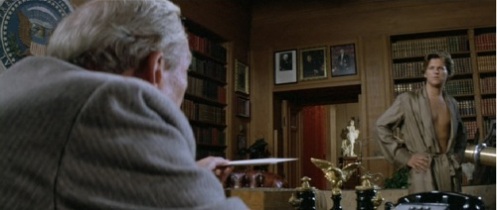
John Huston (foreground) and Jeff Bridges in Winter Kills (1979).
That’s not the only flaw of the book. Like Kael at the time, Taylor sometimes seems to think outrage, anger, and cynicism automatically equals self-loathing (even, at the same time, he champions the films in the book, as well as the critical favorites of the decade, for not providing happy endings or easy answers). In an offhand dismissal of Chinatown (which I, and many others, consider one of the best movies of the decade), which he thinks is full of “cheap and easy despair”, Taylor writes, “Seeing (Chinatown), you could forget that America had just toppled a corrupt presidency”, without mentioning (a) that corrupt president was pardoned and did no time for his crimes, and (b) as Chinatown predicted, power mongers continue to get away with their rape of the land and the people.* And while there’s a lot of nuanced discussion, for example, of blaxploitation movies – Taylor acknowledges their paint-by-numbers plots and dialogue, their sexism, and their crude and cheap cynical nature, yet also does get at the reasons why they resonated with African-American audiences at the time (as well as being in line with the B-movies white audiences embraced at the time – yet when it comes down to defending Peckinpah from charges of sexism, while he acknowledge the misogyny in movies like The Getaway and Straw Dogs, only seems to deliver a half-hearted defense (pointing out the comeuppance a misogynist receives in Cross of Iron, as well as the way the hero in Ride the High Country gets himself killed to protect women from being raped) before dismissing any critic of Peckinpah’s ugly side as people “turning an artist’s output into a balance sheet of correct and incorrect attitudes” (I agree somewhat with this sentiment, but it’s done in a rather dismissive manner).` Finally, he takes what I think are some cheap shots at, among others, Joni Mitchell (when discussing Cisco Pike).
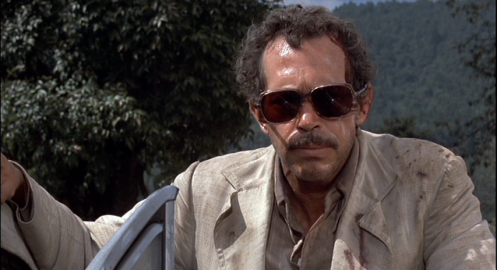
Warren Oates in Bring Me the Head of Alfredo Garcia (1974).
Still, for all of its problems, the book is finally worth tackling. Except for Two-Lane Blacktop, a film I admire more than I like (except for Warren Oates’ performance, which I flat-out love), all of the movies under discussion are well worth watching (two of them – Citizens Band and Winter Kills – made my top 10 lists for the year of their respective U.S. release dates, while two more – Vanishing Point and American Hot Wax – made my honorable mention lists for the year of their respective U.S. release dates), and Taylor does a good job of distilling what works about them (his description of Vanishing Point – “hot rod movie as tone poem” – cuts to the quick), even while acknowledging some of their flaws. Like my other favorite critical study of 70’s films – British critic Ryan Gilbey’s It Don’t Worry Me, about who Gilbey thought were the 10 major American directors of the 70’s (including Demme) – Taylor honors the complexity of the films by not putting them into a nostalgia box (even if he does belong to the “Yesterday was better” club when it comes to these movies), and at his best, writes about them with clarity and obvious passion. That makes Opening Wednesday at a Theater or a Drive-In Near You, for all of its faults, something to savor rather than to roll your eyes over.
*-Taylor, like Kael before him, also dismisses Arthur Penn’s Little Big Man (from the Thomas Berger novel), a revisionist western, in the same way. I confess I haven’t seen it in a long time, so I can’t make any judgments on that, though I do like other Penn films such as Bonnie & Clyde, Alice’s Restaurant (both of which Taylor praised), and Night Moves.
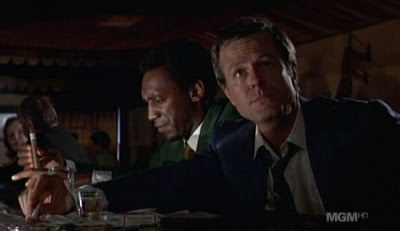
Bill Cosby and Robert Culp in Hickey & Boggs (1972).
`-Taylor’s essay on Hickey & Boggs was written before the rape allegations against Bill Cosby started coming to light. I can’t imagine what Taylor, who spends a lot of time in the essay talking about the appeal of Cosby in general and on I Spy and in the movie in particular, would make of that.

The Beatles performing on The Ed Sullivan Show
About 2/3 of the way through Robert Draper’s fine book Rolling Stone Magazine: The Uncensored History, he writes about a meeting between Jann Wenner and Charles M. “Chuck” Young at the magazine’s New York City office following the memorial for John Lennon. Wenner, of course, was the co-founder, magazine editor and publisher of the magazine (he’s still the publisher), and while he had been a rebel in his teen years and turned to rock music as an outlet for that rebellion, he was now embracing, and publicizing, rock music as celebrity. Young, another teen rebel in many ways, embraced a type of rebellious music (the punk music of the 70’s, in New York but especially in Britain) that offended Wenner, and sought to distance the music from celebrity worship, which he thought cheapened it (one of the few tastes the two of them shared was a love of the Rolling Stones, but even here, Wenner was more a Mick Jagger guy, while Young was more Keith Richards). At the meeting, Wenner, who was still teary-eyed, gushed to Young about the music played at the ceremony. Young, not a Beatles fan in general, said he hated it because, “They played his most insipid shit, and they didn’t play a single rock-n-roll song.” Wenner, who was left speechless at first, replied that he thought it would have been inappropriate.
Draper was obviously using this as a way to illustrate the difference between the two on this and rock music in general, and was clearly on Young’s side. When I first read the book (not long after it came out), I have to admit, though, I was on Wenner’s side; at a memorial service for a giant such as Lennon, what was wrong with being sentimental? Now, however, I’ve come back to Young’s and Draper’s point of view, though for different reasons. As with all other pop culture from the 1960’s (as well as before and after), the Beatles, and Lennon, have been placed in a nostalgia box, with all of the rough edges sanded off, so people can feel comfortable with them. There’s something more particular about the way it’s been done with the Beatles, however, as if those who are guarding the legacy of Lennon and his former group are trying to purge any hint of Charles Manson or Albert Goldman from memory, lest it taint the group. While this is understandable, it’s also resulted in some bland tributes over the years (case in point; the Grammy’s 50 year tribute to them, enlivened only by Dave Grohl’s rousing version of the rarely-played Beatles’ song “Hey Bulldog”). So I was skeptical in checking out In Their Lives: Great Writers on Great Beatles Songs, edited by Andrew Blauner (with a note from Paul McCartney), as it might have been just another example of this. Fortunately, the book is much more idiosyncratic, and enjoyable, than that.
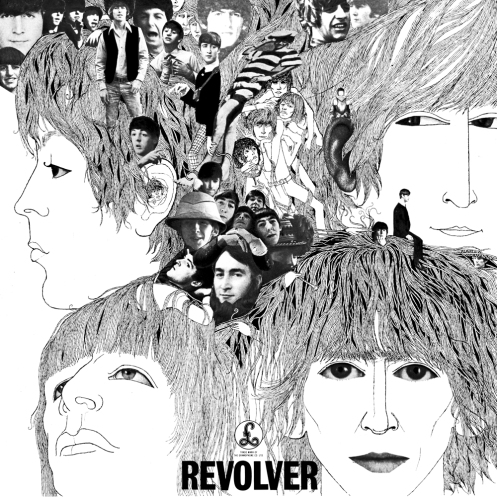
Blauner, who has edited other anthologies (on baseball, Central Park, and Boston, among other topics), was able to get 28 writers (and one add-on; author Francine Prose, of Household Saints and other works, also included a contribution from her granddaughter Emilia Ruiz-Michels), and from a wide variety of backgrounds. Rosanne Cash and Shaun Colvin are singer-songwriters, Bill Flanagan, David Hadju, Alan Light, and Jon Pareles are music critics (for Flanagan, Hadju and Light, among other things), David Duchovny is an actor, Prose, Peter Blauner, Amy Bloom, Pico Iyer, Rick Moody, Joseph O’Neill, Elisa Schappell, Mona Simpson, and Jane Smiley are novelists, Roz Chast is a cartoonist, Chuck Klosterman and Touré are cultural commentators, Gerald Early is a college professor, Thomas Beller, Nicholas Davidoff, and Alec Wilkinson are non-fiction writers, Rebecca Mead writes and oversees the “Talk of the Town” section for The New Yorker (several contributors, including Wilkinson, either are contributors to the magazine or have written for it in the past), Maria Popova is a blogger about books, Ben Zimmer writes about language for The Wall Street Journal and other publications, Adam Gopnik is a book critic for The New Yorker, and John Hockenberry is a journalist for NPR. So they each bring their own experiences to the Beatles songs they write about.
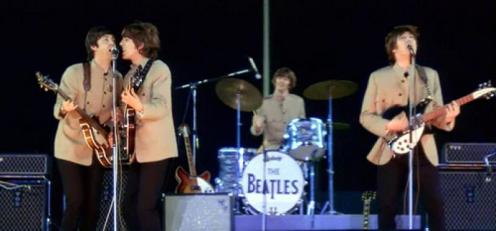
Playing their last concert at Shea Stadium
Many of the people writing in the book were children when the Beatles first came to America, so we get a lot of personal reminiscence. Chast writes about how “She Loves You” felt like an introduction to a world she didn’t even know existed (she was almost nine years old when it came out), Bloom (who writes about “Norwegian Wood”) and Smiley (who tackles “I Wanna Hold Your Hand”) both talk about seeing the band on The Ed Sullivan Show the first time, Mead writes movingly of how she links “Eleanor Rigby” with her childhood friend Chrissie and her family (likewise, Beller partly associates “Lucy in the Sky with Diamonds” with a friend named Brian and his family, though whom he first heard the band). Popova mentions “Yellow Submarine” was a song her parents used to sing to summon her, Early remembers “I’m a Loser” as a song he latched on to even though the African-Americans he grew up with largely dismissed it (as well as the band in general), and Zimmer links his love of “I Am the Walrus” with his childhood love of “inspired nonsense” such as Lewis Carroll (whose works inspired the song).
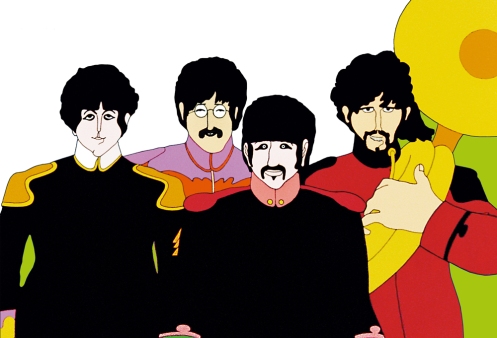
Their animated characters in Yellow Submarine.
But you also get people diving into the history of the songs they write, or looking at the structure of the lyrics and music. Of course, from the critics, this is expected, and you get some ace work here. Pareles, the music critic for The New York Times, talks about the way “Tomorrow Never Knows” was put together, from Lennon’s lyrics being inspired by Timothy Leary and Gandhi, to the Indian instruments George Harrison contributed, to the magnetic tape sound Paul McCartney came up with, to Ringo Starr’s drum work. Light mentions how McCartney’s bass line in “I Saw Her Standing There” is derived from Chuck Berry’s song “I’m Talking About You”. And Hadju writes how “You Know My Name (Look Up My Number)” was inspired by Lennon and McCartney’s shared love of “The Goon Show”, as well as them making fun of the entertainers of their parents’ generation. But they’re not the only ones who break down the songs like this. Mead, in her chapter on “Eleanor Rigby”, also discusses the real people the song was based on, as well as mentioning the different parts each band member came up with (Starr was the one who came up with Father McKenzie “darning his socks in the night when there’s nobody there”). Simpson discusses the article that apparently inspired “She’s Leaving Home”, as well as the fact Lennon’s chorus in the song (“We struggled hard all our lives to get by”) was inspired by things his Aunt Mimi (his guardian growing up) said to him. And though Iyer says he isn’t a particularly big fan of the band (Van Morrison, Leonard Cohen and Joni Mitchell – three artists I personally revere as well – he says are more his speed), he’s able to dissect how the simplicity of the lyrics and music make it work for him.

On the Magical Mystery Tour.
“Yesterday”, of course, is one of the Beatles’ songs that’s always talked about, and the book does hit some of the more obvious songs, like “She Loves You”, “I Wanna Hold Your Hand”, “Eleanor Rigby” (which is my personal favorite of their songs), and “A Day in the Life”, among others. But the book also includes songs that aren’t as well-remembered. In addition to “You Know My Name (Look Up My Number)” (which Hadju admits is usually listed among the worst songs they ever wrote and recorded by the band), there’s also Touré writing about “The Ballad of John and Yoko” (inspired partly by Lennon’s newfound love of Yoko Ono, but also of his weariness with life in the band after the backlash caused by his notorious “we’re more popular than Jesus” remark), Blauner tackling “And Your Bird Can Sing” (one of the best and most overlooked songs from Revolver), Wilkinson discussing “She Said She Said” (another one of the underrated songs on Revolver, and inspired by something Peter Fonda said to Harrison after a bad LSD trip), and Duchovny writing about “Dear Prudence” (from my personal favorite Beatles’ album, The White Album; it was inspired by Mia Farrow’s sister “Prudence”, who had gone to India the same time as they did, to meet the Maharishi). And while there’s no mention of Albert Goldman, Klosterman goes head-on with the issue of Manson in discussing “Helter Skelter”.

Performing on the rooftop while recording the Let it Be movie/album.
Along with songs that aren’t as well remembered, you also get aspects of the band that aren’t as well remembered. The image of Lennon that’s pushed today is the peace lover, the one who sang “Imagine” and “Instant Karma” (two songs I like a lot, btw), but we forget the impish humor Lennon had, as well as the wordplay (as discussed in the chapters on “I Am the Walrus” and “Lucy in the Sky with Diamonds”), and the incisive social observer of “A Day in the Life”, as Davidoff points out in his chapter. With the sentimentality of his solo works (which isn’t always earned), it’s easy to forget not only McCartney’s brilliance as a songwriter with the band, but also the technical sharpness he brought to the studio work (as Blauner admits, McCartney only contributed about 20 percent to “And Your Bird Can Sing”, but the song wouldn’t work nearly as well without it). When Harrison is mentioned in the context of the band, it’s often about the Eastern influences he brought to the table, but he could be as simple, direct, and powerful as McCartney and Lennon, as Prose discusses in her essay on “Here Comes the Sun”. Finally, Starr may have been the one who was most overlooked in the band, but as mentioned above, he contributed a key lyric to “Eleanor Rigby”, he sang a few of their most enjoyable songs, such as “Yellow Submarine” and “Octopus’ Garden” (as Schappell discusses in her chapter), and it’s his voice leading the chorus in the middle of the medley that gives Abbey Road its climax (as well as the drums that dominate the first part of the final part of the medley); “Golden Slumbers/Carry That Weight/The End” (as Moody illustrates in his chapter).
Many books have been written about the Beatles, and doubtless many more will be written about them in the future (Beatles historian Mark Lewisohn recently released the first of what is to be a trilogy of books about the band). It’s important to remember, however, they should be treated as a band, not as an institution, and books like In Their Lives go a long way towards making sure that happens.

It’s been 15 years since the first episode of The Wire – a show I, and many others, consider to be the finest show American TV has ever produced to date (I admit ignorance of shows from other countries for the most part – premiered on HBO. To mark that occasion, I’m going to talk a bit not only why I think it’s so great, but also to clear up a few myths and misconceptions that have built up around the show (as well as about “prestige TV”, the category it gets tagged in), in the hopes people who are hesitant about tackling the show may change their minds and give it a chance. In no particular order (and by the way, these are not direct quotes; I’m paraphrasing):
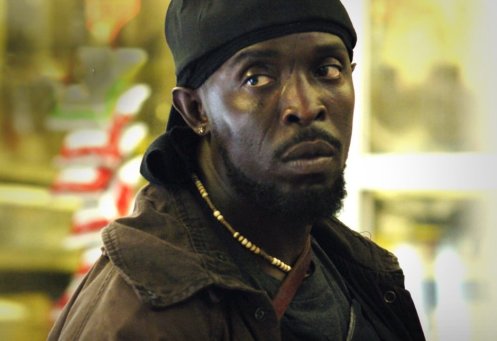
(1) “From what I’ve heard, it’s way too complicated to follow, so I’m going to be lost right from the beginning.”
In order to address this part, I of course must admit The Wire *is* complicated. Each season follows a different storyline: Season 1 takes on the drug war in microcosm through the eyes not only of the cops fighting it, but also the dealers, Season 2 deals with the eroding working class by following a group of dockworkers and the consequence of their leader making a deal with the devil, Season 3 looks at infrastructure among the police, drug dealers, and City Hall (along with being a thinly-disguised take on the War on Terror), Season 4 follows four young teenagers in school and why some go into the drug trade, and Season 5 asks why the media has not reported on the issues the first four seasons tackled. Also, with exception of Season 2 (and, of course, Season 5), these storylines, as well as many (though not all) of the characters carry over to subsequent seasons. Not only that, but the episodes are not stand-alone, and you need to keep all of the storylines and the characters in mind while watching. Finally, David Simon, the former Baltimore Sun reporter who created the show (along with ex-cop and ex-teacher Ed Burns) made it a point to not over-explain everything, so the viewer would have to really pay attention (Simon cared more about getting it right than catering to the average viewer). This was demonstrated most clearly in the fourth episode of the series, “Old Cases”, where Detective Jimmy McNulty (Dominic West) and his partner “Bunk” Moreland (Wendell Pierce) visit an old crime scene and solve the crime, while their entire dialogue consists of variations on “fuck”. So, yes, it is a complicated show.
But you know what other type of television show is complicated? Soap operas, which have several plotlines going on at once, and require you to remember characters from years past. There are also genre shows as varied as Battlestar Galactica, Buffy the Vampire Slayer, Game of Thrones, Lost, and 24, among others, that have complicated storylines and mythologies, with loads of characters, and who, at their best, respect the intelligence of their viewers like The Wire does. And that’s not even mentioning the D.C. and Marvel shows that deal with arc-long seasons and many characters and storylines (themselves based on comic books with even more complicated mythologies and stories, as well as character arcs). If you’re able to follow any of those shows, I don’t think The Wire will be too much of a stretch for you.
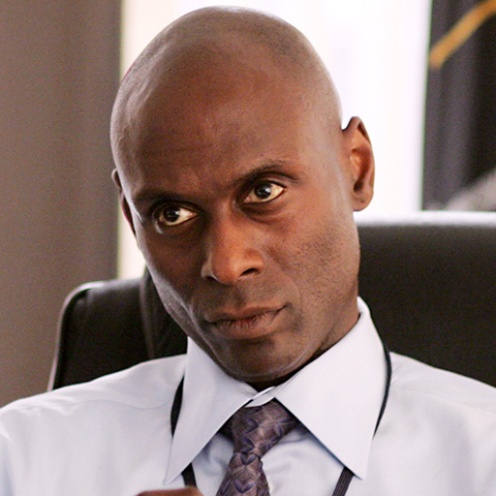
(2) “Aside from being too complex and hard to follow, from what I’ve heard about The Wire, it sounds like homework. I just want something I can enjoy, you know?”
During the five seasons it was on the air, The Wire received a large amount of praise from TV critics, cultural commentators, and politicians (including former President Obama). The show has been praised for its intelligent storytelling, as mentioned above. It’s been called both a Greek tragedy on TV and also a novel on TV (drawing comparisons to Dickens and Tolstoy, among others). It’s been praised for being an indictment of how our cities are being left behind, as well as an indictment of the idea if you work hard, you can make a comfortable living for yourself and your family. It’s been praised for the realism of its storytelling and its characters, whether they be cops, drug dealers, junkies, dock workers, politicians, educators, students, or reporters. Finally, it’s been praised for it’s large, predominantly African-American cast, which had not been seen at the time (I’ll talk more about that below).
All of that praise is well-deserved, and may definitely make the show sound like homework. However, with some exceptions, most people who praise The Wire forget to point out it’s also consistently entertaining and funny. It may seem strange, not to mention insulting, to say a show with this much depth, intelligence, and tragedy (and there’s a lot of tragedy, especially in the next-to-last episode of every season) is also entertaining and funny (certainly, Simon seems to get irritated when people bring that up), but there is plenty of humor among the heartbreak. That scene I mentioned above with McNulty and Bunk is one example. Other examples include Omar Little (Michael K. Williams), the gay outlaw who robbed drug dealers, never pointed a gun at anyone not involved in the drug trade, and who became the breakout character on the show – testifying in court, Stringer Bell (Idris Elba), one of the major drug kingpins in the city, attempting to run a meeting of drug dealers using Robert’s Rules of Order, one drug dealer thinking he’s about to be killed, only to find out his colleague wants him to take care of his fish while he’s in hiding (“These are my tetras. We got Kimmy, Alex, Aubrey, and Jezebel here somewhere. I don’t know; she think she cute”), and many others. And while the show doesn’t go for the type of set pieces seen in other prestige dramas like The Sopranos (or, from what I’ve heard, Breaking Bad), or in genre shows like Buffy (with some exceptions, like a shootout between Omar and his crew with Avon Barksdale’s (Wood Harris) crew), there’s still entertainment value from the humor, the storylines, and the richly developed characters. Keep all of that in mind the next time someone makes it seem as if the show is just homework.

(3) “This show is yet another example of SWPL (Stuff White People Like); black misery being paraded on screen so that white people can get off on it.”
As African-Americans struggle to get represented in movies and on TV (it’s getting better on TV, though there’s still a long way to go), there’s been a debate not only about how much they get represented, but *how* they get represented. In certain quarters, African-American writers and commentators (along with those sympathetic to their view) gripe the only type of entertainment with African-American leads tends to be either historical pieces, or pieces where African-Americans are victimized in some way (or both). They want to see African-Americans in the same type of stories white Americans are in all the time – superhero movies, sci-fi, thrillers, romantic comedies, and so on. They also feel these historical pieces are done to soothe whites today with the idea racism is just a thing of the past, while the victim stories allow whites to feel superior as well by getting off on African-American misery.
All of these are valid complaints, and should be addressed (the fact Hollywood and indie studios have been so slow in addressing these issues is yet another example of their many failings). However, I think it’s highly unfair to tag The Wire with this complaint. True, there are plenty of characters here who are victims in some way: in the street, at school, in politics, in the police department, and in other areas. And while there’s almost no obvious racism on display (the closest is when a random constituent accosts Thomas Carcetti (Aidan Gillen) while he’s campaigning for mayor, and who complains about minorities with a term so archaic Norman (Reg. E. Cathey), Carcetti’s campaign manager, is more bemused than offended), there is racism implied, or even shown (most tragically in a police-involved shooting midway through the series). But the African-Americans in the show aren’t just defined as victims; they have lives outside of that. The show also has African-Americans not only in the drug trade, but in all other walks of life – blue-collar, white-collar, police, politician, civil servant, and more – and while they’re all competing for time with everyone else, you get a sense of their inner lives. None of them come off just as stick figures in a victim narrative. It helps Simon and Burns based them off people they came across in their previous careers, so, for example, Reginald “Bubbles” Cousins (Andre Royo), a drug addict and sometimes police informant, is depicted in a way more honest than we usually see with drug addicts, along with dignity and humor.

(4) “This show is yet another example of prestige TV’s, and popular culture in general, obsession with middle-aged white men, as well as Hollywood’s obsession with white savior stories.”
With the rise of quality TV (as well as quality in TV) in the last 20 years or so, it hasn’t gone unnoticed many of the acclaimed and talked about shows of that time (Breaking Bad, The Shield, The Sopranos) have centered on middle-aged white male main characters. In fact, much of the pushback that’s come against these shows recently has been because of that (along with another reason I’ll get to below). Although I would argue in many cases, the show is not celebrating its main character so much as skewering him (and would also argue, in the case of Mad Men – another prestige TV show that gets lumped in with that group – the show is as much about the women characters as it is about the middle-aged white male main character Don Draper), I certainly agree, as I said before, there should be more diverse viewpoints and main characters on TV (and in other forms of pop culture). But there was a recent article that lumped The Wire in with “middle-aged white male main character” shows, and that has me crying foul.
It’s true Jimmy McNulty is the first major character on the show we see, as he’s chatting up a witness at a crime scene (inspired by an incident Simon depicted in his great book Homicide: A Year on the Killing Streets). And it’s true he’s the driving force behind the major plotline of Seasons 1 and 5, as well as figuring significantly into Seasons 2 and 3 (he was only seen in a few episodes of Season 4 because Dominic West was involved in a movie shoot, and also wanted to spend more time with his family). But as I alluded to above, there’s a large African-American cast on the show, and many of them get equal, if not more, screen time on the show. And while McNulty is praised on the show (both generously and grudgingly) as a good, dogged detective, the show also regularly called out for his womanizing (when the Major Crimes Unit is debating who to send undercover at a brothel for a sting operation, and McNulty walks in, Kima Greggs (Sonja Sohn), one of his colleagues, cracks, “Takes a whore to catch a whore”), his drinking (in one memorable scene, while driving drunk, he smashes his car, gets out, looks at it, gets back in, and smashes the other part), and the fact he feels because of his hard work and intelligence, he feels he can break the rules whenever he wants, whether fudging evidence or going against the bosses (as Bunk tells him at one point, “You’re no good for people, Jimmy”). And while McNulty’s work may eventually get results, most often, it’s not the results he wants; he never gets the main target he wants in the first three seasons, and what he does to try and catch the main bad guy in Season 5 proves to be the final straw for the police department (I’m being deliberately vague here for those who haven’t seen the show).
And that goes for the other major white characters on the show as well – or, at least, the ones who are trying to do good (unlike humps like Herc (Domenick Lombardozzi), a detective who remains almost as useless in Season 5 as he was in Season 1). Frank Sobotka (Chris Bauer), for example, is the main character in Season 2, a dockworker and union rep who is trying to save the port for the union and make things better for his colleagues. In order to do that, however, he’s made a deal with the devil in the form of a mobster known only as The Greek (Bill Raymond), which comes back to bite him during the season. To avoid this coming out, he’s regularly butting heads with Nat Coxson (Luray Cooper), an African-American union leader who feels Frank is overreaching in trying to protect the union (he thinks they should focus on protecting the pier instead of trying to dredge the canal, as Frank wants). Again, as it turns out, Frank comes up short. In Season 3, Carcetti, then a city councilman, starts his mission to run for mayor of the city because he thinks he can help the city, and while he does have genuine concern for trying to tackle the problems facing the city, in the end, his ambition overcomes his desire to do good. Finally, in season 4, Roland “Prez” Pryzbylewski (Jim True-Frost). a former detective, ends up a teacher in the Baltimore school system, but while he also wants to try and help the kids in his class – particularly Duquan “Dukie” Weems (Jermaine Crawford) and Randy Wagstaff (Maestro Harrell), two of the four kids who are the main characters that season (and whose fates are the most tragic) – and unlike Carcetti, doesn’t let ambition trip him up, the only person he ends up helping is himself; helping himself to learn to survive (it’s actually Howard “Bunny” Colvin (Robert Wisdom), another former member of the police department now involved in education, who ends up helping one of the four kids the most; Namond Brice (Julito McCullum), son of Barksdale enforcer Wee-Bey Brice (Hassan Johnson), who starts out in the drug trade but decides it’s no longer for him). This is hardly the stuff of “white savior” narratives, and Simon and Burns are consciously going out of their way to subvert those narratives.

(5) “This is yet another show that claims it wants to help combat the problems we face, but is merely trading in on cheap cynicism about our cities, our institutions, and our country.”
As we’ve seen all too often in this country the past few decades, there is a sizable minority in this country who believes racism is a thing of the past – assuming they admit it ever existed in this country in the first place – and it’s actually the people who are complaining about racism who are perpetuating the problem, and betraying a cynicism about this county. And according to this point of view, people who raise a stink about the way the poor are treated in this country are doing the same thing.
Obviously, I don’t think much of that point of view. Having said that, I will readily admit The Wire is very pessimistic about institutions, or at least at how these institutions have become today, due to a combination of factors (lack of money, bureaucracy, racism – both obvious and covert – government indifference, and more). However, if the show were as cynical as its detractors say it is – both the people in positions of power at those institutions (and their dislike of the show and what it brings up is understandable, if distressing) and the few cultural commentators who have taken issue with the show because of this (most notably film critic Armond White) – it wouldn’t be honoring the people who struggle to better their own lives, as well as those who try to make a difference and help others. There’s Bubbles, as I mentioned above, but also Dennis “Cutty” Wise (Chad L. Coleman), a former member of the Barksdale organization who tries to go back to the life when he gets released from jail, only to decide it isn’t for him, and opens up a boxing gym to try and get poor city kids to box. There’s Bunny, as I mentioned before, who, in Season 3, while he’s a major in the police department, comes up with an audacious plan to try and fight the drug war, and while it has its flaws, it also helps cut back on crime more than the war on drugs ever did. Finally, there’s Cedric Daniels (Lance Reddick), who heads up what becomes the Major Crimes unit in the first three seasons, and Lester Freamon (Clarke Peters), a detective in that unit. Both of them are taken for granted by McNulty at first – Daniels for being a company man, and for possibly having a dirty past (which we get hints at, but never really find out about), and Freamon for being an eccentric (he makes toy furniture) who was originally in the pawnshop unit for 13 years (“and four months”), but both of them not only turn out to be more than meets the eye, but both of them set out trying to improve the police department way of dealing with the drug war (as well as other police work), despite the bureaucracy they’re up against. That’s not cheap cynicism.
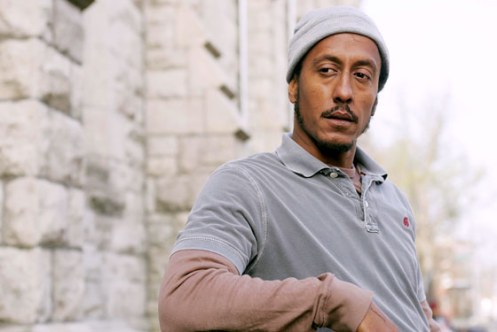
(6) “I’m tired of prestige TV because it’s working to hard to try and be ‘art’, and being more concerned with ‘arcs’ and ‘mythologies’, than in trying to tell a story.”
In his book Adventures in the Screen Trade, William Goldman wrote his famous phrase, “Nobody knows anything”, about how film executives have no idea what will work at the box office. However, he added, they do know what *has* worked in the past, and they figured if it worked in the past, it’ll work again, so they try to create past magic. That also goes for TV executives as well, which is why every new fall season, you see a lot of shows that borrow a lot from, or are blatant copies of, shows that were hits the previous season(s). When that happens, critics and commentators will pick through those shows (most of which are inferior at best, awful at worst), and while the good ones will point out how these lesser shows are learning the wrong lessons from the shows that became hits, other critics (even, unfortunately, the good ones), will start to turn on the type of show that impressed them in the first place. Such is the case with prestige TV nowadays; in addition to the criticism of the “white middle-aged male character” aspect (which, as I said before, is justified, though not in the case of The Wire), there’s also a wish TV shows could just go back to simple storytelling, with stand-alone episodes that were good stories instead of arcs and mythologies, and acting as if they were “better” than just TV.
Now, I will freely admit the copies haven’t been as good as the originals, unless they find a new twist on them (The Americans, for example, is a prestige TV show that has a woman at its center, which is one of the many reasons why I like the show so much), but that doesn’t mean we should act as if prestige TV has never been any good in the first place, or to act as if the cliches of prestige TV are any worse than of any other type of genre. And The Wire demonstrates why the prestige model works when it’s done right. You don’t just get plot arcs, but you also get character arcs, and you see characters develop over the course of the series and grow. Characters like Preston “Bodie” Broadus (J.D. Williams), a low-level dealer in the Barksdale organization. When we first meet him in Season 1, he acts just as another know-nothing low-level dealer. But while Bodie never rises above that level, he starts to show more awareness not only on how to conduct himself (whereas he routinely beats up addicts for no reason in Season 1, he learns by the end of the Season the futility of that), but about his place in the world (D’Angelo Barksdale (Larry Gillard), Avon’s nephew and Bodie’s boss in Season 1, gives him a lesson about chess and how it relates to what they do; in Season 4, Bodie tells McNulty he knows he’s just like a chess pawn). Then there’s Ellis Carver (Seth Gilliam), who starts out as a narcotics detective who is content to, as Herc puts it, collect bodies and split heads “the Western district way”. Yet as the series progresses, he learns the futility of that approach, comes to see the wisdom of Bunny’s strategy in the drug war, and learns enough to be a leader of men to eventually get promoted to lieutenant. In addition to that, with the stand-alone episodes, you also wouldn’t get the breadth of the large ensemble cast. You wouldn’t get to do things like introduce Omar in an episode before he becomes important to the story (Simon had to fight with HBO execs over that part). And you wouldn’t be able to see things pay off with story details introduced early on.
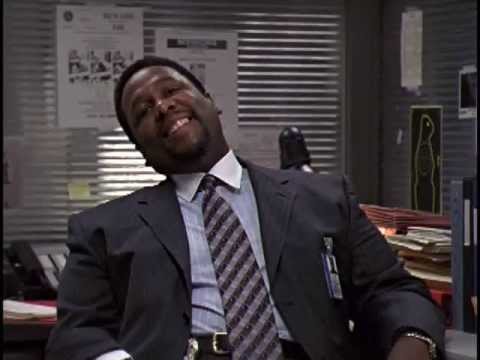
Admittedly, if there’s one criticism the show deserves, it’s the treatment of the women characters. There are interesting women characters on the show – Kima, Beadie Russell (Amy Ryan), a detective on the docks who’s important in Season 2, and Snoop (Felicia “Snoop” Pearson), a fierce killer introduced in Season 3 come to mind – but in general, they’re supporting characters to the men. Also, there are aspects of the show that, due to the ever changing times, come off as dated (the fact a police officer who’s retiring, for example, planning on going into the video store business because he thinks it’s easier money). But in my opinion, The Wire still holds up not only as a show that lays bare what America has sunk to, but also a damn entertaining show as well. Don’t take my word for it, just watch the show. You’ll be glad you did. Just remember, when you walk through the garden, you gotta watch your back.

This is my entry in the “O Canada” Blogathon, hosted by Kristina (Speakeasy) and Ruth (Silver Screenings).. Enjoy!
In 1974, in an effort to provide financial incentives for filmmakers to work in Canada, the Canadian federal government created a tax shelter by increasing what was known as the Capital Cost Allowance to 100 percent (from 60 percent). This allowed film investors to write off the costs of films at 100 percent, provided the films were considered Canadian (that is, were over 75 minutes long, had at least one producer and three-quarters of the above-the-line talent from Canada, and have at least three-quarters of the production and post-production done in Canada as well. The resulting films, generally known as the “tax shelter era films”, are not known as a bright spot in Canadian film history (except for fans of exploitation films), as most of the films made under this system paid little attention to quality (more to the point, most of them were also box office failures). Still, there were a few sprigs of wheat amid the chaff when it comes to Canadian films of this area. One of those was Louis Malle’s film Atlantic City, which came out in 1981, and is, to date, still the only Canadian film ever to be nominated for Best Picture at the Oscars.

Burt Lancaster as Lou.
The film came about when Malle was approached by some Canadian producers, including Denis Heroux (who had produced one of the better tax-shelter films, The Little Girl who Lives Down the Lane, starring Jodie Foster and Martin Sheen), after Malle had recently finished the Minnesota-set documentary God’s Country. They needed to make another film before the end of the decade in order to qualify for the shelter, and they offered Malle a novel to adapt. Malle didn’t like the novel, but he was interested in making another film, and through his then-girlfriend Susan Sarandon (who had recently worked with him on Pretty Baby), Malle met with playwright John Guare (best known at the time for plays such as The House of the Blue Leaves, though he had also co-written the screenplay for Milos Forman’s English-language debut film Taking Off). At the time, gambling had recently been legalized in Atlantic City, and the city was already demonstrating a significant gap between the haves (emphasized by the glamour of the Miss America contest, set there) and the have-nots, so Guare and Malle immediately saw the dramatic possibilities of setting a story there.
The story Guare came up involved Lou (Burt Lancaster), a two-bit gangster who claims to have rubbed shoulders with big names like Nucky Thompson and Al Capone when he was younger, but who is now an errand boy for Grace (Kate Reid), an invalid whose husband Lou used to work for, and whom Lou sometimes sleeps with. One of the few joys Lou has in his life is watching Sally (Susan Sarandon), a food server who’s studying to be a croupier, soaking her naked body every night by the kitchen window (she works at an oyster bar, and the lemon juice washes away the odor from the oysters). The two of them are thrown together when Sally’s estranged husband Dave (Robert Joy) shows up, along with Sally’s new-age sister Chrissy (Hollis McClaren), who’s pregnant by Dave. Dave, unbeknownst to Sally, has taken a package of cocaine meant for someone else from a phone booth, and he’s in town to sell it. While Dave is trying unsuccessfully to sell it in a bar to Fred (John McCurry), a more powerful gangster, Lou, who’s at the bar (taking bets for Fred), sees Dave, and recognizing him from when he came into the building, reaches out to him. Dave ignores him at first, but then flatters Lou by telling him he heard all the way in Vegas how Lou was a man to get things done, and convinces Lou to let him borrow his apartment to prepare the cocaine. Dave lines up a sale with Alfie (Al Waxman), a gambler, but convinces Lou to make the sale since he’s better dressed for the part. However, while Lou is doing this, Dave gets murdered by drug dealers looking for the cocaine he stole. Lou ends up helping Sally, and she’s grateful for it (she even sleeps with him), until they get attacked by the same drug dealers, and she learns what Dave and Lou have been up to.
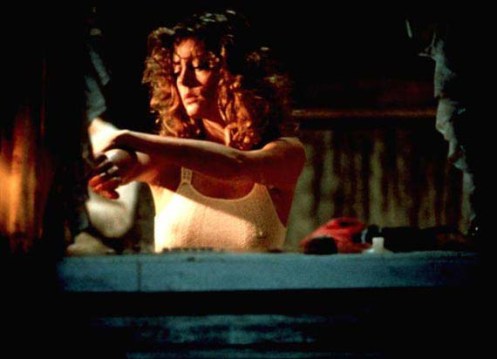
Susan Sarandon as Sally.
Malle was able to make the movie the way he wanted to make it as long as he followed the rules of Canadian tax shelter films. The main crew was made up mostly of Canadians, with the exception of Suzanne Baron, the editor, who was French and had edited several of Malle’s previous films (though she went on to edit only two more, My Dinner with Andre and Crackers), and Michel Legrand, also French, who wrote the score (though Malle ended up using almost all diagetic music and just a fraction of the score). Richard Ciupka, the cinematographer, had been born in Belgium, but had lived in and worked in Canada the previous decade (his only film of note to that point had been a made-for-TV version of A Christmas Carol, set in America – though shot in Montreal – and starring Henry Winkler). Anne Pritchard, the production designer, was born in Ontario, and had served as production designer on such films as The Apprenticeship of Duddy Kravitz (from the novel by Mordecai Richler, rightly considered one of the best Canadian films ever made) and Blood Relatives (one of Claude Chabrol’s lesser-known efforts, shot in Montreal and based on an Ed McBain novel). Finally, Francoise Barbeau, the costume designer, would later receive the Order of Canada, and had worked on an adaptation of Richler’s classic children’s book Jacob Two-Two Meets the Hooded Fang. As far as the cast goes, except for Lancaster, Sarandon, the great French actor Michel Piccoli (who plays the man teaching Sally to be a croupier), and Wallace Shawn (who had a bit part as a waiter who serves Lancaster and Sarandon), most of the cast was Canadian as well.

Kate Reid as Grace.
Though Reid was born in London, England, her parents were Canadian, and they moved to Ontario when Reid was less than a year old. She was mostly known for her work on stage (she appeared in such plays as The Rainmaker, Three Sisters, and various Shakespeare works), though she had appeared in such films as Sydney Pollack’s This Property is Condemned (as Natalie Wood’s mother; adapted from a play by Tennessee Williams), Robert Wise’s The Andromeda Strain (as one of the team of scientists trying to stop an alien virus; based on the novel by Michael Crichton), and Sidney Lumet’s Equus (as the wife of the psychiatrist played by Richard Burton; based on the play by Peter Shaffer). After Atlantic City (for which she won a Genie, the Canadian equivalent of the Oscars), she went on to have a recurring role on the original incarnation of the prime time TV soap opera Dallas, and as Dustin Hoffman’s wife in a made-for-TV version of Arthur Miller’s Death of a Salesman, among other roles, before finally succumbing to brain cancer in 1993, at the age of 62.
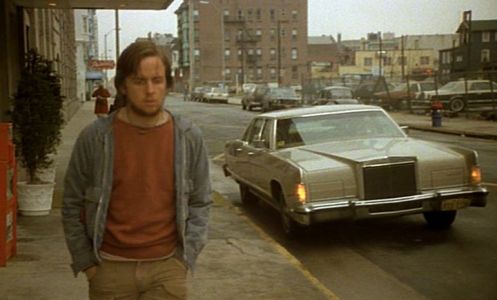
Robert Joy as Dave.
Joy, born in Montreal, was the son of a Newfoundland politician, and started out in a theater troupe there. To American audiences, he’s probably best known today as Dr. Sid Hammerback, the “quirky” medical examiner on CSI: NY. Prior to Atlantic City, he hadn’t done much, but after the movie, he enjoyed a prolific career as a character actor in both movies (in such movies as Desperately Seeking Susan, Radio Days, and Longtime Companion) and TV shows (playing a recurring role on The Equalizer).
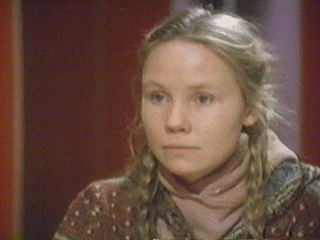
Hollis McClaren as Chrissy.
Prior to Atlantic City, McClaren, born in Toronto, was best known for the comedy Outrageous!, where she played a pregnant woman with schizophrenia rooming with a gay hairdresser/female impersonator (Craig Russell). She and Russell appeared in the sequel 10 years later, but her career has been sporadic, most notably the drama Marion Bridge (with Molly Parker and Ellen Page), and made-for-TV movies about Martha Stewart and Elizabeth Smart.
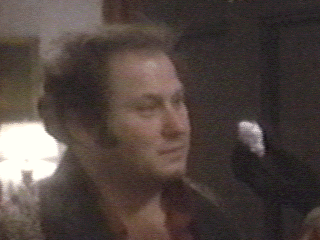
Al Waxman as Alfie.
Waxman was mostly known in Canada at the time for being the star of the sitcom King of Kensington, which was the only successful Canadian sitcom to ever air (it ran for five seasons). After Atlantic City, he got some jobs in American movies (Class of 1984, Switching Channels), but his most memorable appearance in America came on television, where he played police lieutenant Bert Samuels on Cagney & Lacey. He died in 2001.
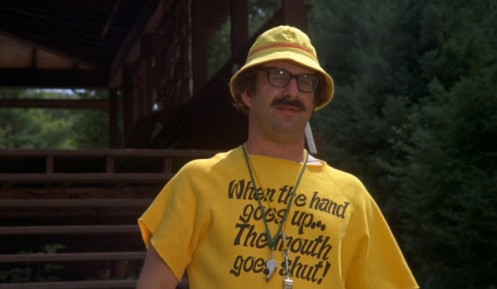
Harvey Atkin as he appeared in Meatballs (1978) two years earlier.
Another actor from the movie who later showed up on Cagney & Lacey (as desk sergeant Ronald Coleman) was Harvey Atkin, who plays a bus driver. Atkin had previously appeared as the somewhat hapless camp director Morty (“Hi, Mickey!”) in Meatballs (another Canadian tax shelter production), opposite Bill Murray. Though he’s appeared in movies (two Mordecai Richler adaptations; Joshua Then and Now and Barney’s Version) and on other shows besides Cagney & Lacey (a recurring role as a judge on Law & Order: Special Victims Unit), Atkin is probably best known for his voice work, particular as the voice of King Koopa on The Super Mario Brothers Super Show.
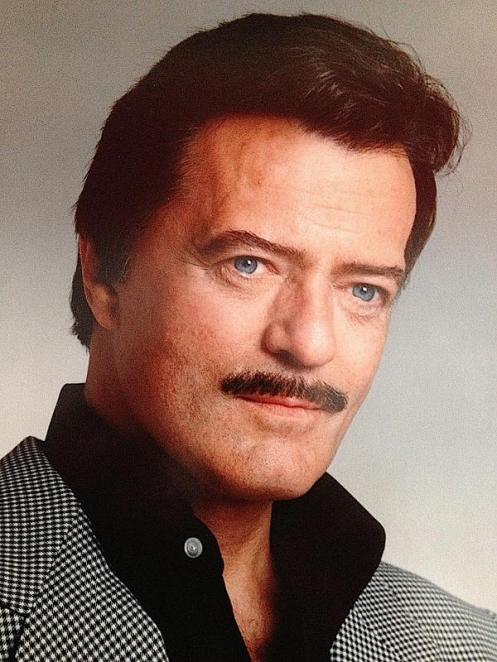
Robert Goulet.
Robert Goulet made a cameo appearance as a singer, more or less based on himself, doing a dedication at a hospital wing where Sally goes to identify Dave’s body. Goulet started out on stage, as Lancelot in Camelot, opposite Richard Burton and Julie Andrews, when it was on Broadway. Though he appeared in other plays (Man of La Mancha), as well as in movies (Beetlejuice), he was mostly known for his career as a singer, and his appearances in Atlantic City and Las Vegas. He died in 2007.

Moses Znaimer as a drug dealer.
Arguably, the one who became the biggest name afterwards wasn’t really much of an actor, but made his mark elsewhere in the media landscape; Moses Znaimer, who plays one of the drug dealers pursuing Sally and Lou. Znaimer started out working for the Canadian Broadcast Corporation (the CBC, similar to the BBC), and produced, directing, and hosted several shows for them starting in 1965. In 1969, Znaimer quit the CBC, and three years later, founded Canada’s first UHF channel, City TV (“This is City TV, everywhere!”). When that channel became a success, and was purchased by Canadian media conglomerate CHUM in 1981, Znaimer went on to launch several other TV stations, including Much Music (the Canadian equivalent of MTV), Cable Pulse 24, Space, Book Television, and the Law and Order Channel. Though he stepped down from the executive posts he had at CHUM in 2003, he still maintains close ties with it, and has also launched his own media company with Zoomer Media.
As for the film itself, of the handful of films Malle made in America (the others were My Dinner with Andre, Crackers, Alamo Bay, Vanya on 42nd Street, and the documentaries And the Pursuit of Happiness and God’s Country), this one is my favorite, even though it may take a couple of viewings to fully sink in (as it did for me). Malle and Guare show a collision of the old and the new without getting heavy-handed about it. That dedication scene is a good example; Malle and Guare don’t skimp on the conflicted feelings Sally has, and they don’t linger too long on Goulet, making the joke (as well as the hilariously awful song he sings) all the funnier. As for the performances, Lancaster looks more relaxed here than at any other time in his career, and when he finally becomes the big shot he’d always bragged about being, he brings a palpable joy to it, yet also lets you see how unnerving it can be. Sarandon had been acting in movies for a decade prior to this movie (beginning with Joe in 1970), this was the first role she had gotten that was worthy of her talents (she was good in Pretty Baby, but it was a secondary role). There’s no playing to the audience during the scenes when she’s washing herself off, and the scene where she finally registers what she’s gotten herself into if she stays with Lou is also a great moment of quiet acting. Piccoli’s accent is a little thick at times, but he’s very good otherwise as the charming if repellent mentor. Reid is perfect as a woman who hasn’t entirely grown up. And Waxman shows some nice comic timing when he first sees Lou and makes a crack about Medicare. Malle and Guare were never to work again (they had planned on making a movie about Abscam with Dan Aykroyd and John Belushi, but that fell through after Belushi died), but Atlantic City stands out as a great collaboration, as well as one of the better films from the Canadian tax shelter period.

Throughout history, there have been great artists whose work has been all of a piece; each movie, novel, song, or what have you, has been essentially the same each time. There might be some slight variation in place, but you could still recognize it as distinctly theirs. Then there are the artists who change their style (for lack of a better word) every time they release a new work. In certain circles, this is seen as being a dilettante, or as someone who can’t make up their mind, but I see it as having an adventurous spirit, of not wanting to repeat themselves. Few artists epitomized this adventurous spirit more than David Bowie, who passed away on January 10 (two days after his 69th birthday and the release of his final album, Blackstar) after a long bout with cancer. Throughout his music career, he went through numerous personas (Ziggy Stardust, Aladdin Sane, the Thin White Duke) and musical styles (glam rock, soul – or as he dubbed it, “plastic soul” – industrial music), and put his own stamp on them while remaining true to the impulse that led him to stretch himself in that direction in the first place. Others have written, and will write, in more detail about his music career, but I’d like to concentrate on his film career. Although he wasn’t exactly prolific in that department, only making 21 feature-length movies in his career, and I’ve only seen a handful of them, his choices suggest the same daring and restless spirit that characterized his music.
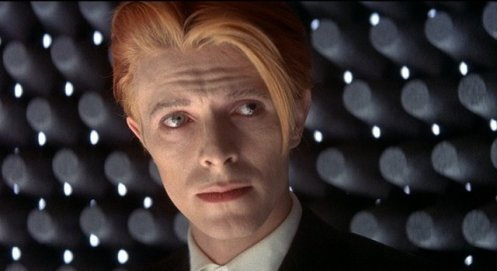
As the title character in The Man who Fell to Earth.
Though he had a small part in the 1969 war comedy The Virgin Soldiers, and had made a couple of shorts as well, Bowie’s real film break came in 1976, with Nicolas Roeg’s The Man who Fell to Earth. I’ve already written about that film, but it’s important to point out this could easily have just been a film exploiting the alien persona Bowie had cultivated to that point. After all, the plot is about an alien, going under the alias Thomas Jerome Newton (Bowie), who visits Earth, starts a technology conglomerate, falls in love with a hotel maid (Candy Clark), and becomes targeted by the U.S. government. But what Roeg and writer Paul Mayersberg (adapting the novel by Walter Tevis) do with this instead is to emphasize how alienated Newton himself is from Earth, despite the ways he does seem to embrace it; his pursuit of money, his constant watching of old movies on TV, and the way he drowns his sorrows in alcohol (mirroring Bowie’s own real-life drug addiction at the time). And in the end, instead of the alien leaving a message for earth, or turning on it, Newton is betrayed by almost everyone he’s close to (even Clark’s character). So instead of exploiting his persona, Bowie turned to a filmmaker, and a story, about that persona being exploited, showing both his daring and his savvy even then. And while inexperienced as an actor, Bowie does show both the business savvy that allows him to make so much money, as well as the physical and emotional vulnerability of his character, and holds his own with actors like Clark and Rip Torn.
I’ve never seen Just a Gigolo, Bowie’s follow-up film, where he plays a WWI soldier returning to his home in Berlin (made during Bowie’s Berlin album trilogy), but while it had an interesting group of people involved (David Hemmings directed, and Bowie’s co-stars included Hemmings, Marlene Dietrich and Kim Novak), Bowie apparently didn’t think much of it; in an interview with Rolling Stone in 1987, he claimed everyone knew it was bad while they were making it, and it seems to have been largely forgotten today (it’s never been released on DVD). Although it was also a flop upon release, Bowie’s next film, The Hunger, has become a cult film, thanks to its subject matter (vampires), as well as the fact it was the first feature film directed by the late Tony Scott, who followed this up with the smash hit Top Gun. Bowie plays a lover of a vampire queen (Catherine Deneuve), and as with The Man who Fell to Earth, his character is sickly, though here, it’s because of lack of blood. Along with his bleached-out look, Bowie gives his character a hoarse voice, and it fits the character. The movie, unfortunately, is more interested in flashy surfaces than anything else, and the promising work Bowie and co-star Susan Sarandon (as a medical researcher who gets involved with Bowie and Deneuve) gets lost amidst the flash. The other major movie Bowie was involved in that year was Nagisa Oshima’s Merry Christmas, Mr. Lawrence, and I have to admit I couldn’t warm up to this one either, although it also plays off of Bowie’s persona and showed his willingness at the same time to take chances. Here, he’s a British POW at a Japanese camp during WWII who finds himself strangely drawn to Captain Yonoi (Ryuchi Sakamoto), the commander. Bowie is convincing as a soldier, does his best not to appear “modern”, and is willing to follow Oshima’s depiction of the homoerotic overtones of the story (in real life, Bowie declared in the 70’s he was bisexual, though he sometimes tried to walk that back, at one point – in an interview with Life magazine – asserting instead he was a “trisexual – I’ll try anything once”), but Oshima’s style here, as in his controversial In the Realm of the Senses, leaves me cold.
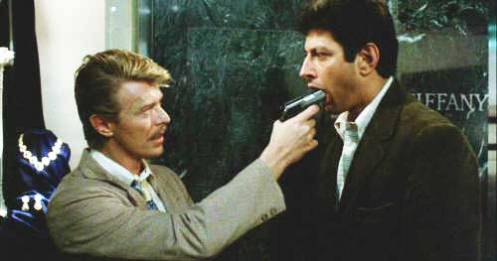
As a hitman menacing Jeff Goldblum in Into the Night.
Bowie was a friend of Eric Idle’s, which led him to make a brief cameo that same year in Yellowbeard, opposite Idle and Madeline Khan (in his novel Road to Mars, Idle models a robot character after Bowie’s persona from his Let’s Dance period, and Idle apparently wanted Bowie to play the part if it was ever filmed, but it never was). And while I have no proof of this, after watching Bowie in John Landis’ would-be comedy/thriller Into the Night, I’d swear Bowie played the role of a hitman by asking, “What if Idle’s ‘Nudge Nudge’ character was a psychotic instead of just a desperate virgin?”It’s not just the dialogue, but Bowie’s inflections when he’s saying things like “Very good” like Idle did in the Python sketch. Bowie manages to bring a jolt of energy to the proceedings, and manages to be both funny and dangerous, even in scenes like getting in a knife fight with a rival hitman (Carl Perkins, of all people).

Performing “That’s Motivation” in Absolute Beginners.
In later years, Bowie would disparage the music he made during the 80’s after Let’s Dance, calling it his “Phil Collins” years – he disliked the fact he was trying to cash in on his success, and wasn’t taking the chances he had taken in the 70’s. I hope he didn’t include the music he made for Absolute Beginners and Labyrinth in that judgment, because the music he wrote for both movies is, I think, some of the most enjoyable music he’s ever done. I’m also a big fan of both movies, and him in them as well. In the former, based on the Colin MacInnes novel about British youth in the late 50’s, he plays Vendice, a corrupt businessman who tempts Colin (Eddie O’Connell), the photographer hero of the story, into selling out. Bowie worked at an ad agency in the 60’s, and apparently based his character on bosses who would affect an American accent, which is why he does so here at times. It can get distracting while you’re watching, but it’s mitigated by the rest of the film (which, while being the rare film that could be said to have too many ideas, is energetically made by director Julien Temple) and by Bowie’s songs. He performs the title track, a lovely and affecting jazz-tinged mid-tempo ballad, and also the song “That’s Motivation”, where he entices Colin, and also gets to dance (adequately) on a typewriter (he also croons “Volare” at one point). Because the movie was taken away from Temple in the editing room, there’s no way of telling whether Bowie had a bigger role, especially when he’s revealed as being the main person behind the part that drives the second half of the movie (driving all of the immigrants out of Notting Hill, where Colin lives), but for the time he’s on-screen, Bowie is convincingly seductive, plastic, and devilish.

As goblin king Jareth in Labyrinth.
Bowie gets to play evil again in the latter as Jareth, the Goblin King, who takes the baby brother of Sarah (Jennifer Connelly), a fairy-tale loving teenage girl (who had wished the goblins would take her brother away), and then tries to prevent her from getting him back. The movie was the last one directed by Jim Henson, and as with other Henson projects, Bowie (as well as Connelly) interacts with Muppets, in this case the goblins and other creatures. Bowie, who took the movie based on Brian Froud’s designs of these creatures, is clearly having fun with his role, and works well with both Connelly and the other Muppets. Plus, the songs he wrote for the movie are very enjoyable, especially “Underground” (which plays over the opening and closing credits) and “Magic Dance” (the introduction pays off of an exchange in Cary Grant movie The Bachelor and the Bobby-Soxer), which may not be my favorite Bowie song ever, but is one I will always dance and sing along to. And while the “Bowie is a sex god!” mantra that has apparently become part of some of the fandom of this movie is overdone, there’s also no denying the seductiveness Bowie brings to Jareth, especially in the dream sequence when Sarah, having bitten a poisoned plum, imagines she’s at a ball in which Jareth pursues her and dances with her (while “As the World Falls Down”, another one of the songs Bowie wrote and performed for the movie, plays in the background). At the same time, within the limits of a kids movie (ex-Python Terry Jones, credited with the screenplay, had originally written a darker version of the film), Bowie also never lets you forget Jareth is a bad guy, especially when he’s changing the rules on Sarah.
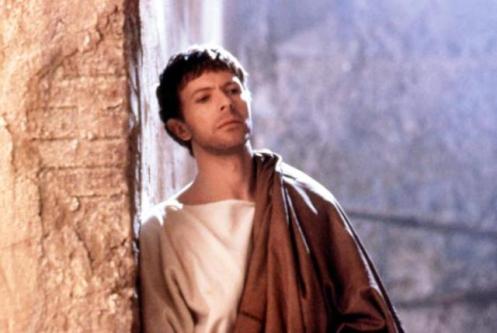
As Pontius Pilate in The Last Temptation of Christ.
Both Absolute Beginners and Labyrinth met with mixed to indifferent reviews and were box-office flops (don’t know what Bowie thought of Labyrinth, but according to the interview I alluded to earlier, he liked Absolute Beginners and saw it achieving cult status). Both of them have developed followings over the years (though for the latter, there’s a group that insists it’s only worth watching as a camp classic, a notion I find noxious), but they effectively killed off any chance of Bowie becoming a movie star, which, in retrospect, seemed like something he didn’t want to pursue anyway. Instead, he continued to work with interesting people and on offbeat projects. Martin Scorsese originally wanted Sting to play the role of Pontius Pilate in his controversial film version of The Last Temptation of Christ, but when that fell through, Bowie stepped into the role when Scorsese was finally able to get the film made. At first, when you’re watching, you might think Bowie’s performance is flat, especially contrasted with the energy from Willem Dafoe as Jesus. However, as a friend of mine pointed out, the conception of Pilate here is of one who is bored with yet another “rebel” being brought in front of him and doesn’t want to make a decision about it. Yet Bowie exudes authority in the scene and is convincing as a ruler. Another tab at a lead role came a few years later in Richard Shepard’s underrated, offbeat comedy The Linguini Incident, where he plays a bartender/con man who has designs on $50,000 left in the safe of the restaurant he works at, but has to compete with Rosanna Arquette (as a waitress/escape artist) and Eszter Balint (a performance artist) for the loot. Though there’s a nominal story (in addition to the plot about the money, Bowie and Arquette fall in love with each other), it’s less important than the characters and the atmosphere Shepard creates (this is the type of movie where Balint tries to hold up the restaurant, then claims it’s part of her act), and Bowie fits in very well, again by underplaying.
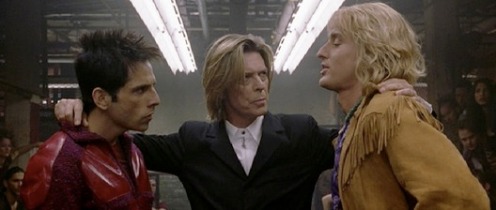
As himself, refereeing the walk-off between Ben Stiller and Owen Wilson, in Zoolander.
In addition to music and movies, Bowie was also interested in art, fashion, and technology, which led to three enjoyable cameos. In Julian Schnabel’s Basquiat, his biopic about the controversial graffiti artist (played by Jeffrey Wright), Bowie turned up in a small role as Andy Warhol, who encouraged Basquiat. Bowie, of course, had known Warhol, and captures Warhol’s mannerisms and voice perfectly. He also interacts well with both Wright and Dennis Hopper (as Bruno Bischofberger, an art dealer). And Bowie also showed an ability to laugh at himself by showing up as himself in Ben Stiller’s fashion satire Zoolander, refereeing a walk-off between Stiller and his rival Owen Wilson (“If nobody has any objections, I believe I might be of service”). Finally, in one of his last film appearances, Austin Chick’s August, he plays an investor whom Josh Hartnett alternately woos and insults to try and get money for Hartnett’s dot-com company. Bowie doesn’t have much screen time, but he adds authority to the role, and to the movie. But it was an appearance in another movie about technology (among other things), playing a real-life inventor, that gave him his last great role.

As Nikolai Tesla in The Prestige.
I’ve already written about The Prestige, but I barely spent any time talking about Bowie’s performance as Nikolai Tesla, the famed rival to Thomas Edison in the quest to harness electrical power. At first, we just know Tesla as this reclusive figure Robert Angier (Hugh Jackman), a famed magician (under the name The Great Danton) is trying to get ahold of because he knows Tesla built a machine for his bitter rival Alfred Borden (Christian Bale) for his trick The Transported Man. When Angier goes to visit Tesla at the beginning of the film, Alley (Andy Serkis), Tesla’s assistant, puts him off (though he’s polite about it once he recognizes Angier). Finally, nearly 50 minutes into the film, Tesla appears, and naturally, it’s walking through a mass of electric bolts shooting through the air. As he greets Angier, Tesla tells him how much Alley enthuses about his act, grasps one of Angier’s hands, and then asks him to hold out the other. Alley puts a giant light bulb in Angier’s hand, and immediately, the light bulb comes on. Angier, surprised, asks what’s producing the electricity, and Tesla replies, “Our bodies, Mr. Angier, quite capable of conducting and, indeed, producing energy.” As with so many of Bowie’s other performances, it’s all the better for being underplayed, whether he’s explaining what drives him (“You’re familiar with the phrase ‘man’s reach exceeds his grasp’? It’s a lie; man’s reach exceeds his nerve”) or warning Angier not to let his obsession control him. Bowie only appears in a few scenes in the movie, but somehow, the movie would feel incomplete without him.

As his Screamin’ Lord Byron character in Jazzin’ For Blue Jean.
Though Bowie may not have had the most prolific movie career, he was as much a visual artist as he was a musical one. Like many other musicians in Britain during the 60’s and 70’s, he was making music videos long before MTV, and while some of them were merely performance clips, even these were made interesting simply how Bowie was dressed for the occasion (looking very much like an alien, for example, while performing “Space Oddity”). Others conveyed the showmanship, sense of humor (“Fashion”), and even the vulnerability (“Ashes to Ashes”) contained in his songs. And when the MTV era came around, he was tuned into that as well, even able to slip messages into his videos;”Let’s Dance”, for example, the title track of his album, looks to make a comment on both consumerism and the treatment of aborigines alongside his rather buoyant tune. Not long after Michael Jackson proved long-form music videos could work with his video for thriller, Bowie and Temple took Bowie’s song “Blue Jean” (from his ill-fated album Tonight) and made a 17 minute short film called Jazzin’ for Blue Jean, where he plays both Screamin’ Lord Byron, a reclusive rock star who might have been one of Bowie’s album characters (he even dresses like one while performing “Blue Jean”), and Vic, a nerdish man who tries to impress his date (Louise Scott) by pretending he “knows” Byron. It’s no more than a trifle, but it’s an amusing one. In that Rolling Stone video, he claimed, however, he was happy to see people turning away from music videos, and seemed to be implying he was getting bored with them. By that time, however, even if Hollywood hadn’t quite embraced him as an actor, they were starting to catch up with his music.
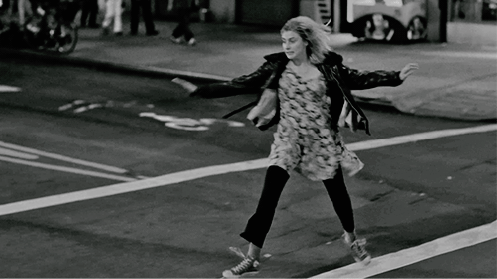
Greta Gerwig twirling and running to “Modern Love” in Frances Ha.
On Bowie’s IMDb page, it lists over 450 movies, TV shows, awards shows, and so on where his music has been used, and the 80’s is when it started to pick up. Some of it may have been songs Bowie expressly wrote for movies, like the title track of Paul Schrader’s remake/re-imagining of Cat People (more on that in a moment) or the song “This is Not America”, which he did for the movie version of The Falcon and the Snowman. But a lot of it was Bowie’s older music. John Hughes’ use of Bowie’s lyrics in “Changes” to open The Breakfast Club (“And these children that you spit on as they try to change their worlds/Are immune to your consultations, they are quite aware of what they are going through”) set the note of defiance for the rest of the film. Both David Fincher and David Lynch found inspiration in Bowie’s turn towards industrial music in the 90’s for their credits sequences, Fincher with “The Heart’s Filthy Lesson” in Seven (over the closing credits) and Lynch with “I’m Deranged” in Lost Highway (over both the opening and closing credits). “Under Pressure”, which Bowie co-wrote and co-recorded with Queen, may be overused nowadays, but it still feels fresh to encounter it in the memorable sequence from Grosse Pointe Blank when hitman Martin Blank (John Cusack), having reluctantly gone to his high school reunion, even more reluctantly holds a former classmate’s baby and finds himself thinking about the sanctity of life for a change. Cameron Crowe (who had interviewed Bowie in the 70’s for Playboy) uses Bowie’s version of Velvet Underground’s “Waiting for the Man” for his semi-autobiographical film Almost Famous, in the sequence where Stillwater goes to Cleveland and lead singer Jeff Bebe (Jason Lee) and guitarist Russell Hammond (Billy Crudup) indulge themselves in their respective hotel rooms while magazine writer William Miller (Patrick Fugit) – based on Crowe himself – sits glumly, waiting for an interview that will never come. Quentin Tarantino appropriated Bowie’s “Cat People” for his movie Inglourious Basterds in the sequence where Shoshana (Melanie Laurent) gets herself ready to take her revenge on the Nazis for massacring her family. Tarantino would not be the last person to appropriate Bowie’s music for his own purposes; in his film Frances Ha, Noah Baumbach borrows from Leon Carax’s Mauvais Sang in his use of “Modern Love”, with his heroine (Greta Gerwig) running down the streets of Manhattan, just as Denis Lavant had run through the streets of Paris in Carax’s film (with slight differences; Carax shoots long takes in level tracking shots and in color, while Baumbach uses jump cuts and an overhead camera, and shoots in black and while. Also, Gerwig is filled with joy, while Lavant starts out in agony before turning himself over to joyful abandon). And while Joe Wright’s action fairy tale Hanna mostly uses the Chemical Brothers for the score, there’s one great sequence where the title character (Saoirse Ronan) hides out in the camper of the family who’s befriended them, and watches them as they dance around to “Kooks”, showing the camaraderie and family love she’s missed.
But if there’s one film that I would point to as the best example of using Bowie’s music, that would be Wes Anderson’s The Life Aquatic with Steve Zissou. Met with critical derision from many circles when first released – even among those who had been fans of Anderson’s earlier work – it has since rightfully been reappraised. As with other Anderson films, the song choices (as opposed to the score, written by former Devo member Mark Mothersbaugh) are all tied together thematically, but here it’s dominated by Bowie. Instead of just replaying Bowie’s music however, we hear Brazilian musician Seu Jorge’s covers of such Bowie hits as “Starman”, “Five Years”,and “Rebel Rebel” (Jorge, who plays a member of Zissou’s (Bill Murray) crew, performs many of these songs on camera). You might expect this to have a distancing effect on us, especially since Jorge sings them all in Portuguese (he did all the translations himself). But it makes a perfect sense, in a way, to show how Bowie’s music has crossed over into several different cultures, and doubly appropriate in a film set on a vessel that travels all across the globe. Anderson saves the use of the real thing for two memorable sequences. The first is when Zissou meets Ned Plimpton (Owen Wilson, like Murray a member of Anderson’s repertory company; he also co-wrote Anderson’s first three films), an airline pilot, at a reception on Zissou’s boat. Plimpton introduces himself and tells Zissou he may in fact be Zissou’s son from a previous relationship, though he admits he doesn’t know for sure. Zissou is overwhelmed by the news (he’s already coming off his declaration that he intends to kill a shark that killed his best friend, played by Seymour Cassel), so he excuses himself and walks up to the ship’s stern to have a cigarette. During their conversation, the instrumental part of Bowie’s “Life on Mars” has been playing, but as Zissou walks up the ship, Bowie’s voice breaks in, underlining the emotional turmoil in Zissou’s heart. Anderson bookends this at the end (in what also serves as an homage to the end credits sequence of The Adventures of Buckaroo Banzai Across the 8th Dimension) with Zissou, leaving the successful premiere of his latest film (in addition to being a ship captain, Zissou, like Jacques Cousteau, is also a documentary filmmaker), walks down the steps to Bowie’s “Queen Bitch”, and as with the film Anderson is paying homage to, Zissou then starts walking down the docks and is joined one by one by members of his crew (Jeff Goldblum, who plays the new husband of Zissou’s ex-wife (Anjelica Huston), was also in Banzai), contrasting the note of melancholy earlier with the note of triumph in this song.

During his musical career, Bowie was often regarded by the critics as being cold or inward; as Robert Draper wrote in his book Rolling Stone: The Uncensored History, the glam period Bowie participated in was met with both amusement and disdain from the magazine’s music writers. Even other musicians got into the act; in an interview with the magazine for the 20th anniversary, John Fogerty used Bowie’s music as an example of people turning away from the idealism of the 60’s (as well as the desire to make the world a better place). Of course, they were missing the boat; Bowie may have been using irony throughout his many poses (an attitude often misunderstood by American critics of music and movies), but underneath was something that was both heartfelt and, at the same time, allowed, and even invited, you to have a laugh at the absurdity of it all. That’s why so many people were drawn to his music, why his music was so often used in movies, and why, even though he didn’t make many movies, Bowie was able to leave just as indelible mark in them as he did in music.

This is my contribution to The Criterion Blues Blogathon. Enjoy!
When Henri-Georges Clouzot once asked Jean-Luc Godard whether every film should have a beginning, middle and end, Godard famously replied, “Yes, but not necessarily in that order.” Godard aside, most movies today do have a beginning, middle and end in that order. It’s a method of storytelling, to be sure, that’s produced some of the greatest films ever made. But there’s nothing wrong with filmmakers trying to break up that method of storytelling, so that things aren’t in order. One of the few directors who challenged this way of storytelling on film was Nicolas Roeg. Roeg was known for his fragmented narrative, of having flashbacks and flash-forwards (terms he’s claimed he’s never really understood), and challenging viewers in more ways than just in the narrative. When Roeg was still making films (his last theatrically released film, Puffball (2007), only had a limited released in the U.S.), his style received a mixed reception from critics and audiences, but nowadays, Roeg has been receiving plaudits from filmmakers (Danny Boyle and Steven Soderbergh both praise him on a recent DVD), and from Criterion, which has released five of his films on DVD. It’s those five films that I’d like to focus on.
———————————————————–
Roeg, of course, started out his career working in the camera department, first as an assistant cameraman in 1951 (for the film Calling Bulldog Drummond), then moving up to camera operator (on such films as The Man Inside and The Sundowners), and eventually cinematographer on such films as Lawrence of Arabia (for which he shot the second-unit cinematography), Masque of the Red Death, Fahrenheit 451, the 1967 adaptation of Far from the Madding Crowd, and Petulia. In 1970 came his first film as director, Performance, where he shared a directing credit with Donald Cammell. Though this tale of a gangster (James Fox) on the lam who hides out with a reclusive rock star (Mick Jagger) features Roeg on cinematography, and also has a fractured narrative (not to mention casting a musician in one of the lead roles, which he would do twice more in the next decade), it’s considered as much a film by Cammell as it is by Roeg. Walkabout (1971), released a year later), would be Roeg’s solo directorial debut.

The girl (Jenny Agutter) and the aborigine (David Gulpilil) try to help the boy (Luc Roeg).
I’ve always put Roeg in the category of filmmakers who are interesting even though they’ve never quite been able to get the film that’s in their heads onto the screen, which is ironic since Roeg has insisted he never plans anything out in advance when it comes to shooting. Walkabout, for me, is the film that’s Roeg’s most successful attempt at putting it all together. Based on a children’s novel called The Children by Donald G. Payne (writing under the name James Vance Marshall), it tells the story of two children, a teenage girl (Jenny Agutter) and her younger brother (Roeg’s son Luc, billed here as Lucien John), who are stranded in the outback area of Australia, and the help they receive from an aborigine boy (David Gulpilil) who’s about the same age as the girl (as the opening credits explain, when an aborigine boy reaches the age of 16, he goes out into the wild to live off of the land, which is called going on a “walkabout”). The aborigine helps the two children find water (which is their major need in the desert) and food, but while the boy develops an instant liking to the aborigine (the feeling is mutual), things are more complicated with his sister.
Roeg and playwright Edward Bond (best known at the time for the play Saved), who wrote the screenplay, made some crucial changes to the novel. First, while in the novel, the boy and girl’s parents died in a plane crash that stranded the children, here, the boy and girl get taken to the outback by the father, who tries to shoot them before killing himself (the boy doesn’t know what’s going on, but the girl does, and manages to flee with her brother before their father commits suicide). Also, the way the aborigine meets his eventual fate in the movie is different than in the novel. Finally, they play up the girl’s budding sexuality (including a scene where the girl swims nude in a lake, though it should be said it’s done without any voyeurism), which also contributes to the aborigine’s fate. But mostly, Roeg and Bond are faithful to the essential story, and the author’s way of capturing the landscape. Obviously, a lot of that can be done through the photography, and Roeg, who also served as the film’s cinematographer (the last time he’d do so on a feature film), brings out the beautiful parts of the landscape while also making clear how it can seem forbidding and dangerous, and all of this without turning the film into a travelogue. Roeg also follows another Godard dictum here in showing the interior lives of his characters by staying outside, and using the landscape to do so. That becomes especially apparent near the end, when the aborigine does a dance for the girl that he clearly means one way and the girl takes another way.
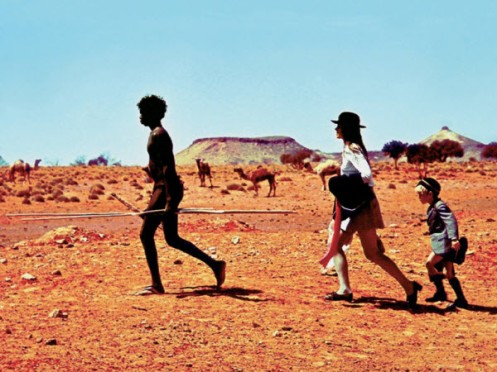
The three on their journey.
While Agutter had been making movies for nearly a decade before this film, Walkabout was Luc Roeg’s first (and, as it turns out, only) film as an actor, and the same with Gulpilil, but Roeg gets natural performances out of all three of them. Luc Roeg comes off as a natural child, being able to relate to some things immediately without truly understanding everything that’s going on. Gulpilil, one of the few well known aborigine actors in Australia (he has also appeared in such films as Mad Dog Morgan, Crocodile Dundee, and Rabbit Proof Fence, is primarily a dancer (a documentary on the Criterion DVD about his life and career shows him how to teach people aborigine dance), and his fluidity of movement certainly suggests that. And he and Roeg work hard to try and avoid the “noble savage” cliche (not entirely successfully, it should be said; it’s the one failure of the film) and make him into a distinctive character. Finally, while Agutter is the one experienced actor among the three, she works well with the others, become like a mother figure to Roeg’s character while still being enough of a teenage girl to be convincingly freaked out by what she’s going through. In Australia, the novel has long been considered a children’s classic, and Roeg’s film remains a classic in its own right.
————————————————————
As I mentioned before, Roeg started out as a cameraman, and has therefore always considered movies visual stories, and screenplays, and the written word in general, to be blueprints and not movies. What makes that ironic is Roeg has not only worked with playwrights (who hold the written word paramount), bus has often adapted the written word of novels, plays, and short stories to the screen. Such was also the case with Roeg’s next film, Don’t Look Now (1973), which was adapted from the short story by Daphne du Maurier.
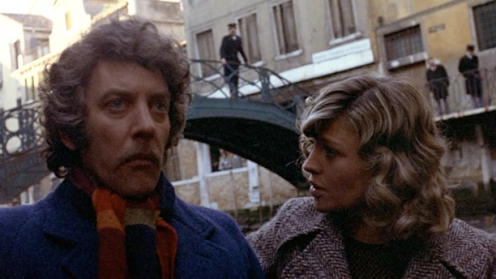
Laura (Julie Christie) trying, and failing, to convince John (Donald Sutherland).
As with the story, the movie follows John Baxter (Donald Sutherland), an art restorer, and his wife Laura (Julie Christie) during their time in Venice. Part of the trip is for business – John is restoring a church – but they’re also there because John hopes it will help them both, especially Laura, get over the death of their daughter Christine (Sharon Williams). Early in their trip, at a restaurant, they see two old women who are sisters – Wendy (Clelia Matania) and Heather (Hilary Mason) – who seem a bit bizarre but harmless, and who are staring at them. Wendy gets something caught in her eye, and since Heather is blind, Laura volunteers to help her in the ladies’ room. Heather also claims to be psychic, and in the bathroom, she claims she has a message from Christine, telling Laura and John not to worry, which causes Laura to faint later, but also makes her the happiest she’s been since Christine died. John doesn’t believe this, and doesn’t want to believe, but it turns out John may be psychic as well in his own way, which leads to danger for him.
Again, Roeg, along with writers Chris Bryant and Allan Scott (the latter of whom went on to write or co-write four feature films and one made-for-TV film for Roeg), changes du Maurier’s story while still keeping the essence of it. In the story, for example, Christine died of meningitis, while in the movie, she drowns in a pond outside their home, and while wearing a red mac (the color red appears as a motif throughout the entire film, an invention of Roeg’s), and is tied in to show John’s premonition (he runs outside without hearing a scream, though he’s too late). Also, the movie adds the famous sex scene between John and Laura, which is intercut between the two of them getting ready (in interviews, Roeg said he wanted to show one moment of intimacy as a contrast to the many disagreements they have throughout the film, but it’s also implied they’re trying to have another baby to try and replace Christine). Still, Roeg keeps the essence of the story all the way until the end, when John makes two tragic mistakes.
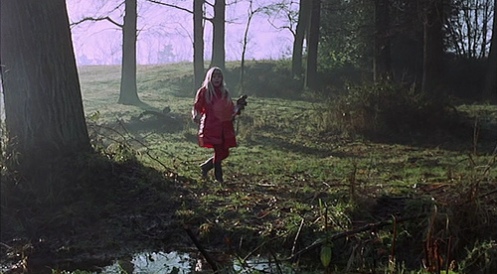
Christine (Sharon Williams) in the woods before her death.
Roeg, cinematographer Anthony B. Richmond (who went on to shoot two more features and two made-for-TV movies for Roeg), and editor Graeme Clifford (who went on to become a director in the 80’s) try to avoid using the obvious locations in Venice, using the walkways, the age of the buildings, and the bleached out colors to help create menace. And while there are flashbacks (often to the time of Christine’s death), they aren’t used in a flashy way, and John’s other “premonitions” aren’t juiced up, so Roeg can’t be accused of hyping the material. Yet, even given how the tale winds up, and the inclusion of a subplot involving a serial killer, I must admit I find myself sympathizing with Pauline Kael, who felt Roeg’s technique was so cold it never allowed us to feel anything for the characters, and that it was dressing up Gothic material that didn’t need dressing up. Despite the efforts of Sutherland and Christie, who are both very good, the film always keeps us at a distance from the characters, especially the supporting ones (Roeg’s attempts to show ambiguity regarding the sisters – as to whether they’re frauds or not – also comes as cheap). Of all the films of Roeg’s that have been released on Criterion, Don’t Look Now is my least favorite, even with all that’s good in it.
————————————————————-
One of the more important aspects of Roeg’s career that needs to be examined is the way he uses music, particularly recorded music, to underscore the action. The radio the young boy carries around in Walkabout (playing Rod Stewart’s “Gasoline Alley” and Warren Marley’s “Los Angeles”, among other songs), Mick Jagger’s electrifying performance of “Memo From Turner” in the hallucinatory sequence in Performance, and his staging of Verdi’s “Un Ballo in Maschera” in Aria being among the highlights. Along with that goes his willingness to use musicians in leading roles in films. Probably no better example of that tendency came in Roeg’s following film, The Man who Fell to Earth, with David Bowie in the title role.

Thomas Jane Newton (David Bowie).
Bowie plays Thomas Jerome Newton, a man who comes to New Mexico and starts a technology company thanks to Oliver Farnsworth (Buck Henry), a patent lawyer who helps patent his inventions, and Dr. Nathan Bryce (Rip Torn), a cynical, womanizing chemistry professor whom Newton hires as his science consultant. Newton also finds himself falling in love with Mary Lou (Candy Clark), a hotel maid who later helps him in his business. Gradually, we find out what that business is really for; Newton is actually an alien from another planet who’s trying to raise enough money so he can build a spaceship, go back, and rescue the survivors, including his wife and children, who are suffering because the planet has run out of water. However, the U.S. government, in the form of Peters (Bernie Casey), has other ideas.
I’ve never read the Walter Tevis novel the movie is based on (adapted by Paul Mayersberg, a former film critic who also went on to write Croupier over two decades later), so I don’t know how Roeg handled the transition from novel to screen. I know Roeg’s use of flashbacks to Newton’s planet, where he and his wife (also played by Clark) and children are struggling to survive, give us the emotional connection that I was missing in Roeg’s previous film. And Roeg doesn’t try to accentuate Bowie’s already alien persona any more than necessary (we don’t see him in his alien guise while on Earth except for two scenes, and only for a short time in both of them). He grounds how alienated Newton is from everyone else in the normal, everyday circumstances of Newton being addicted to watching television, and later, drinking alcohol (an unintended resonance to the addiction storyline is Bowie himself was going through a drug addiction at the time). as well as seeing how everyone one else eventually ages while Newton, essentially stays the same, at least until maybe the end. And once again, Roeg, working here again with Richmond and Clifford, uses the landscape to play against Newton without going overboard with it.
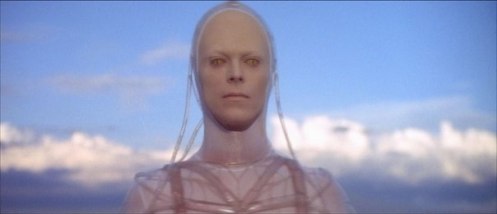
The alien (Bowie).
The American release was cut by 20 minutes, and some scenes were rearranged differently. The Criterion version restores Roeg’s original intent, and makes things clearer (along with, as is Roeg’s method, being more sexually explicit). It’s still somewhat confusing at times – it’s never really made clear to us why Bryce ends up selling Newton out – but it’s always dazzling to look at, thanks to the flashbacks (also shot in New Mexico), and its portrayal of an alien not as a menace, nor as a “pure” being, but someone subject to the same desires as all of us. Bowie has been a man of many personas over the course of his career, and this is one he wears rather well, while Henry is perfect as the ultimate corporate drone, and Torn does well in playing against type as someone more intellectual than emotional. Clark can strain at times, but she has good chemistry with Bowie, and brings off a tough scene when she finds out who Newton really is. Bowie was originally supposed to write the music for the movie as well, but for whatever reason, that didn’t work out; still, the music for the film is well used, as well as the collage of images from the televisions Newton is glued to. The Man who Fell to Earth is the type of film I was thinking of when I originally claimed Roeg could never quite get the movie in his head onto the screen, but it’s definitely an engaging and interesting movie all the same.
————————————————————-
Much has been made of the relationship between directors and actors who have served as their on-screen muse. John Ford and John Wayne, Akira Kurosawa and Toshiro Mifune, Martin Scorsese and Robert De Niro; these are all familiar pairings to us. But there are also the intertwined careers of directors and actresses, such as Josef Von Sternberg and Marlene Dietrich, Ingmar Bergman and his many leading women (particularly, of course, Liv Ullmann), and Woody Allen with Diane Keaton and then Mia Farrow (more recently, Nicole Holofcener and Catherine Keener as well). Then there’s Roeg and Theresa Russell, an actress who, at the time they got together, was known only for playing a small part in Elia Kazan’s adaptation of The Last Tycoon, and as Dustin Hoffman’s girlfriend in Ulu Grosbard’s Straight Time. While the seven films the two of them made together (six features and one short that was part of the anthology film Aria) aren’t as well known as his 70’s films (and Cold Heaven, adapted from the novel by Brian Moore, is definitely a misfire, albeit a daring one), two of them are among Roeg’s very best. The first one they did together was Roeg’s most controversial, Bad Timing (1980), released in the U.S. with the subtitle A Sensual Obsession.

Milena (Theresa Russell) seduces Alex (Art Garfunkel).
Roeg’s previous films, even though they had a non-linear narrative, did have a relative order that viewers could follow, but Bad Timing (which Roeg made after an attempt to make a Flash Gordon movie fell through) contains Roeg’s most fractured narrative yet (written by Yale Udoff). Nominally, it’s about two American expatriates in Vienna – Alex Linden (Art Garfunkel), a psychiatrist and professor, and Milena Flaherty (Russell), a recent divorcee, who get involved in a passionate affair, and about how Netusil (Harvey Keitel), a police inspector, investigates what was apparently a suicide attempt by Milena. But the film is told in flashback after the opening credits scene of Alex and Milena in an art gallery (scored to Tom Waits’ “An Invitation to the Blues”), flashing back and forth between Milena in the hospital – as well as Netusil questioning Alex as to how she got there – and Alex and Milena’s relationship. This adds up to Roeg’s most fragmented narrative yet.
In an interview on the Criterion DVD, Roeg and producer Jeremy Thomas talk about how the film is essentially a memory piece, and how the editing style (the film was edited by Tony Lawson, who went on to edit eight more films of Roeg’s) helps bring that out. A lot of that is through the juxtaposition of images, in which we can go, for example, from Alex and Milena having passionate sex to Milena on the operating table, and from Netusil entering Alex’s room in the present to a flashback of Alex and Milena in that room. It also involves cutting from the physical objects in the room. Roeg may only really handle one or two (at most three) people in a room, or an area, at a time, but he’s alive to the culture people engage in (when he glances at a collection of Harold Pinter plays that Milena is reading, Alex can guess she’s having an affair with an actor), and the way a person’s belongings can help define them (Milena’s room, which is full of belongings and clutter, seems alive in a way Alex’s more orderly room doesn’t, which helps reflect their personalities). The film is also a study of two people seeking control. Alex is trying to control and define Milena, who doesn’t want either (which is both the cause of the excitement and tension in their relationship), while Netusil is trying to impose control over Alex by getting him to admit to what he believes really happened to Milena that night.
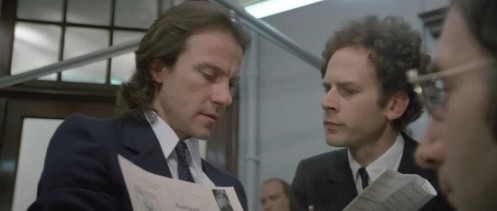
Netusil (Harvey Keitel) questions Alex.
There was a lot of controversy surrounding the movie when it came out, in reference to the explicitness of the sex scenes and other imagery, to what really happened to Milena (which caused a member of the British film company the Rank Organization to call it “a sick film for sick people”), and even surrounding the casting of Garfunkel and Keitel. But as disturbing as what happens to Milena is, it does speak to Alex’s need for control (in a sick, perverted way, of course), and Roeg and Richmond (Tony Lawson, who had edited Barry Lyndon for Stanley Kubrick, was the editor here; he went on to edit eight more films for Roeg) are careful not to be exploitative in rendering the scene. As for Garfunkel and Keitel, I feel they actually work for the movie. There’s always been something closed off about Garfunkel, and that works here for his character, but Roeg also gets him to be angrier than he’s ever been on screen, while Keitel, his faltering with the Viennese accent aside, is surprisingly restrained as the methodical (if not quite as intellectual as he thinks) inspector. Rounding out the male roles is Denholm Elliot as Milena’s ex, and the one man who never sought to control her, and Elliot brings a welcome melancholy to the role, as well as pent-up anger. The film, however, belongs to Russell. This is definitely a playing-to-the-seats performance, but it works for the character, as Milena is always struggling against Alex’s conception of her, and is forever reacting to that. And she remains one of the sexiest presences I’ve ever seen on screen (it’s no accident Pete Townshend originally wrote the Who song “Athena” as an ode to Russell, called “Theresa”). Bad Timing continues to provoke to this day, but I think it stands as one of Roeg’s best.
————————————————————-
Bad Timing wasn’t well received by critics or the box office, and Roeg’s follow-up film, Eureka, starring Gene Hackman as a prospector, ended up being barely released, to critical and public indifference. However, Roeg managed to recover to adapt, of all things, a play, when he took on a film version of Terry Johnson’s play Insignificance, and delivered yet another one of his best films.
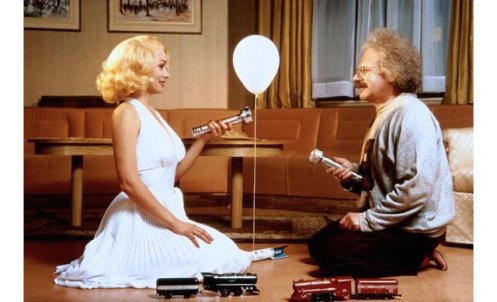
The Actress (Theresa Russell) demonstrates the theory of relativity to The Scientist (Michael Emil).
As with the play, the film takes off from the famous image of Marilyn Monroe’s white dress blowing up while she’s standing over the subway grate in Billy Wilder’s The Seven Year Itch. Taking place over the course of one night, it imagines that Monroe (Russell), known only here as The Actress, goes to a Manhattan hotel where, as it happens, Albert Einstein (Michael Emil, brother of filmmaker Henry Jaglom), known here only as The Scientist, is staying. Einstein is in town to speak at a peace conference, though Joe McCarthy (Tony Curtis), known here only as The Senator, has other ideas; he wants Einstein to testify in front of HUAC and denounce communism. Meanwhile, Monroe’s ex-husband, Joe DiMaggio (Gary Busey), known here only as The Ballplayer, just wants Monroe to come back to him, but acts crazy jealous around anyone who shows interest in her (we first see him watching and seething during the recreation of that famous shot from Wilder’s film). Monroe, on the other hand, just wants to discuss with Einstein the theory of relativity, the creation and meaning of the universe, and other matters of, well, insignificance.
The main subject of Johnson’s story seems to be celebrity, in particular how a public persona can often hide what’s really underneath. Roeg’s contribution to this was, as usual, to show people’s pasts through flashbacks, from Monroe in auditions being ogled by talent agents to Einstein in war-torn Europe, to DiMaggio as a young player and McCarthy as an altar boy. And what the characters talk about, particularly when Monroe is demonstrating the theory of relativity to Einstein, is the clearest way of illustrating the huge gap between what we think we know and what we actually know, whether about the theory of relativity (Monroe admits while she can explain it, she doesn’t really understand it) or about a person in general (McCarthy thinks he can get Einstein to testify simply by either appealing to his intellect or by bullying him, while DiMaggio thinks if he cajoles Monroe enough, he’ll get her to come back to him. Both of them are wrong). And despite the fact most of this (except for the scene recreation and the flashbacks) is set in the hotel room and hallways, Roeg, Lawson, and cinematographer Peter Hannan (who shot, among other films, Monty Python’s Meaning of Life and Withnail & I) never make it seem stagy.

The Senator (Tony Curtis) confronts Einstein.
Because the characters are not really DiMaggio, Einstein, McCarthy and Monroe, the actors are a little more free to play around with the material. Busey, for example, may seem at first to be too energetic and mercurial to play the notoriously aloof DiMaggio, but he carries himself like an ex-athlete, and makes that manic nature work for him as someone who doesn’t like the fact the world no longer acts the way it should now he’s retired. I’m not familiar with Emil’s other work as an actor (I’m not a fan of Jaglom’s films, in which Emil was a regular), but he captures both Einstein’s intellect and his sadness that the world was becoming something more horrible than he imagined. Curtis gives one of his best performances as McCarthy, re-imagining him as if Sidney Falco hadn’t been killed, but had gone on to outdo J.J. Hunsecker in fake charm, intimidation and manipulation, though showing the sweat much more. Finally, while Russell may be nobody’s idea of Monroe, and comes off as a little too affected at first, gradually I warmed up to that once I realized her conception of Monroe was of someone aware of the affectation but resigned to it nonetheless even as she struggled to break free of it. For the movie, Roeg and Johnson added an elevator operator played by Will Sampson who claims Einstein is part Cherokee – meaning he has a deeper understanding of the world than anyone else – and that comes off as borderline patronizing (though Sampson at least plays the part well). And some of the scenes drag at times. Still, overall, Insignificance serves as an entertaining meditation on our knowledge of the world, or lack thereof.
————————————————————-
After that film, Roeg’s one major film was his adaptation of Roald Dahl’s classic children’s novel The Witches, with the help of producer Jim Henson’s creature effects and Anjelica Huston’s terrifying performance as the villain of the film. After that, however, his career dried up; aside from an ambitious but flawed “straight” made-for-TV version of Joseph Conrad’s Heart of Darkness, with Tim Roth as Marlow and John Malkovich as Kurtz, Roeg was reduced to directing episodes of TV and soft-core cable porn such as Full Body Massage. In the past decade, Roeg’s career has been rightly re-evaluated, and he’s considered one of the best filmmakers to come out of Britain in the 70’s, and Criterion showcasing these five films of his stands as fitting tribute.

This is my entry in the Swashathon, hosted by Fritzi Kramer (Movies Silently). Enjoy!
In The Rocketeer, Timothy Dalton plays Neville Sinclair, a 1940’s action/adventure movie star modeled on Errol Flynn (though it takes as gospel the false accusation Flynn was a Nazi spy, but that’s another story). When we first meet him, he’s playing a character in a period adventure movie, engaging in a sword duel with the villain of the story. He swings over to a table after unmasking himself, and as he’s about to drink from a goblet of wine that’s there, the leading lady character of the movie gushes, “O, my sweet prince, that I might drink from your lips as deeply!” (the first take we see her doing, she gives a wooden line reading; the second is better) Sinclair’s character, smiling, finishes his drink, inclines his head towards her, and then goes back to fighting. This scene captures, in a nutshell, what’s so appealing to those of us who are fans of swashbuckling films; not just the action scenes (which can be exhilarating when done right), but also the sense of joy that they’re done with, and the humor that they’re done with. And few films have done this as well as the 1952 film The Crimson Pirate, directed by Robert Siodmak and starring Burt Lancaster.

Burt Lancaster as the title character, at the beginning.
Lancaster plays the title character, also known as Captain Vallo, a pirate who, along with the rest of his crew, is merely out to get whatever they can in terms of money and adventure. At the beginning, he and his men capture a British ship headed to the Caribbean by pretending to be a ship that’s been laid waste to by scurvy. When Vallo finds out one of the passengers is Baron Jose Gruda (Leslie Bradley),a British official sent to stop a rebellion being led in the Caribbean, led by an unknown figure nicknamed “El Libre”, he decides to forego the usual pirate method of looting and pillaging. Instead, he’ll steal the arms the ship has, sell them to El Libre, and then sell El Libre out for double the money back to Gruda. However, things don’t quite work out the way Vallo planned; he ends up falling in love with Consuelo (Eva Bartok), the daughter of El Libre, getting double-crossed by his own crew (who are not happy that he seems to have turned idealistic), and then having to rescue them when they in turn are double-crossed by Gruda, as well as rescue Consuelo.

Vallo with Ojo (Nick Cravat).
This was the third and final time Lancaster and Siodmak teamed up. Their previous films, The Killers (1946), based on a short story by Ernest Hemingway, and Criss Cross (1949), from a novel by Don Tracy, were both film noirs. However, this was less of a stretch for them than you might think. Lancaster, of course, was originally an acrobat, and had already done films showing off his athletic skills, such as Rope and Sand (1949), Vengeance Valley, Jim Thorpe: All American (both 1951), and The Flame and the Arrow (1950), the film Pirate most resembled. And while Siodmak had mostly done thriller/noir films in American – aside from the two films with Lancaster, he also did three films with Ella Raines (Phantom Lady, The Suspect (both 1944), and The Strange Affair of Uncle Harry (1945)*), and the HItchcockian The Spiral Staircase (1946) – but he had also done films like Son of Dracula (1943) and the campy Cobra Woman (1944), which were considerably lighter in tone. Also, while original writer Waldo Salt had written a more serious screenplay about tyranny before being blacklisted, Siodmak and new writer Roland Kibbee (who had written Ten Tall Men, starring Lancaster, and who would go on to write three other films starring Lancaster – including The Midnight Man (1974), which he and Lancaster co-directed) changed it into a comedy, though there are traces of political commentary (when Consuelo at one point pleads for Vallo to fight with them because it’s “decent”, Vallo replies, “All my life I’ve watched injustice and dishonesty fly the flag of decency. I don’t trust it”). Certainly, getting there was no picnic; Lancaster and Siodmak had a falling out during the making of the film (which went way over budget), and Siodmak would complain later about how much of a bully Lancaster was during the production (whether it was because of this or other reasons, Siodmak never worked in Hollywood again)~. Yet none of that tension showed up on screen, and like all of the best entertainments, it works because it appears effortless.

Vallo and Consuelo (Eva Bartok) in disguise.
A great deal of credit for why The Crimson Pirate works so well goes to the technicians working with Siodmak. Cinematographer Otto Heller was well into his third decade of a long, if not particularly distinguished, career up till then (his most well-known credit up to that point was the British crime drama They Made Me a Fugitive; later, he went on to shoot such great films as The Ladykillers, Peeping Tom, and The Ipcress File), and he gives the film a vibrant and colorful look. The fight scenes are also staged well, and he and editor Jack Harris (who worked as an editor for David Lean on Brief Encounter, Great Expectations, and Oliver Twist, and also edited The Ladykillers) keep the action coherent, even when such anachronistic weapons as nitroglycerin are used (courtesy of Professor Prudence (James Hayter), who ends up helping Vallo). Also, there’s the boisterous score by William Alwyn (who worked with Carol Reed on Odd Man Out and The Fallen Idol, and went on to do the score for A Night to Remember and Shake Hands with the Devil), which manages to go for grandeur yet stay light at the same time. Finally, Kibbee deserves credit as well for helping keep a light touch as well, and delivering a knowing wink at the genre conventions – when Humble Bellows (Torin Thatcher), one of the pirates, leads a mutiny against Vallo, he explains it’s practically a pirate’s duty to double-cross anyone.
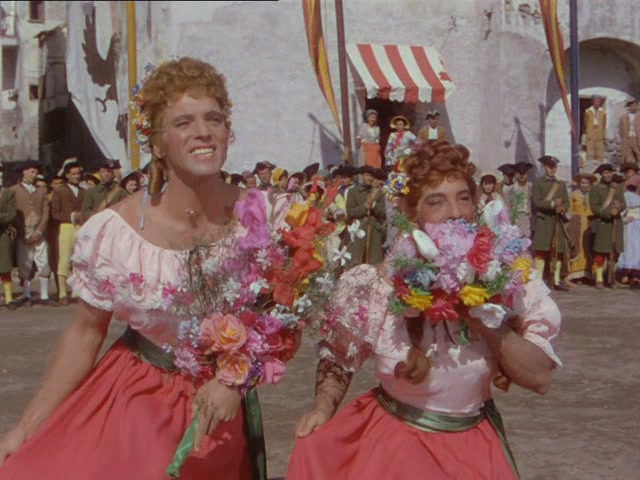
Vallo and Ojo disguised as flower girls.
Still, the lion’s share of the credit should go to Lancaster, who also co-produced with his partner Harold Hecht (though Hecht had produced three previous films of Lancaster’s, this was the first time Lancaster officially served as producer; they went on to produce 15 more films together through their production company). Lancaster has had the reputation of being one of the few actors who did his own stunts (he started out as a circus performer), and while this has been disputed (on The Flame and the Arrow, Don Turner, one of the stuntman, pointed out he had doubled for Lancaster in the fight scenes), there’s no doubt Lancaster brings immense physicality to the role. Whether swinging from one end of his ship to another, eluding a squadron of soldiers that are chasing him and his first mate Ojo (Nick Cravat – more on him in a moment), or fighting them on board his ship, Lancaster is entirely convincing in the role, even if he looks too clean-cut to be a pirate (one of my former co-workers groused about his impeccably white teeth – which he shows off at various times – but to me, it’s all part of the film). And Lancaster’s magnetism and sheer joy in performing never curdle into smugness. He also is able to handle Vallo’s change of heart as well, without it making it seem like it comes out of left field (he also pulls off a scene in drag – when he, Ojo and the professor disguise themselves as flower girls to rescue Consuelo – despite how big he is).

Vallo and Ojo fight off the British soldiers.
Cravat, Lancaster’s former circus partner who had become Lancaster’s trainer in real life, is also a hoot. As in The Flame and the Arrow, the first time Cravat and Lancaster had appeared together, Cravat plays a mute character, the better to hide his thick Brooklyn accent. In this movie, Cravat is almost as good as Harpo Marx at playing a comic mute (which is saying something) – especially when he demonstrates “paying through the nose” to a group of amused ladies of the court – and is equally adept as Lancaster at the action scenes. The rest of the cast, while not memorable, is serviceable, with Bradley, Hayter, and Thatcher being the standouts (this film also provides early roles for Christopher Lee, as a British military attache, and Dana Wynter, as a woman Gruda is with when Vallo first takes over his ship), and at the very least, they all seem in on the fun as well. There are also some sigh gags thrown in, as when Valley, Ojo, and the professor carry a boat from the water onto ground, and we can only see their feet as they try to get away (the first Pirates of the Caribbean movie pays homage to this scene), and it’s an example of the type of gag that makes this movie seem effortless and come off as actually entertaining, making it one of the reasons why The Crimson Pirate stands as a superior example of a swashbuckler movie.
*-Raines also appeared in Siodmak’s Time Out of Mind (1947), but this was not a thriller/noir.
~-According to Lancaster biographer Kate Buford, Lancaster was going through marriage troubles at the time, and was also under investigation by the HUAC for his liberal political views, though whether this had to do with his on-set behavior remains unclear.

From July 17 to August 27, the Brooklyn Academy of Music (BAM) spotlighted indie films of the 80’s. Leaving aside the question of what an indie film really is, when it comes to movies, the 80’s are generally thought of as the decade when blockbusters took over, “high concept” became the order of the day, movies became more conservative both politically and financially, and, in general, movies became more homogenized. Also, the thinking goes, indie films weren’t a thing until either 1989 (when sex, lies & videotape won the Palme D’Or at Cannes) or 1992 (when Reservoir Dogs exploded at Sundance). Like many media-written histories when it comes to movies, this is an oversimplification of the times. It is true the 80’s were top-heavy with blockbusters, but it’s also true the 80’s saw the rise, or introduction, of many indie directors who would soon become a force. The series at BAM pays attention to the obvious names, like Jim Jarmusch, Spike Lee, and David Lynch, but it’s nice to see they were also spotlighting the names that tend to get forgotten when it comes to movies in general and indie movies in particular, like Victor Nunez (whose A Flash of Green was shown in the series), John Sayles (represented by Matewan) and especially Alan Rudolph.
To be sure, there are probably good reasons why Rudolph isn’t a name brought up too often when discussing directors in general and indie directors in particular. For one thing, Rudolph hasn’t had a movie released since 2006’s Intimate Affairs (aka Investigating Sex), which was actually filmed in 2001 (the last movie he made was 2002’s The Secret Lives of Dentists). For another, Rudolph has never had a big following among audiences; none of his movies have really been hits. There’s also the fact his films all together have garnered two Oscar nominations (Best Original Score for 1984’s Songwriter, and Best Actress for Julie Christie in 1997’s Afterglow). And while his movies have played at various film festivals, and he’s had his fair share of fans among critics (Roger Ebert put Choose Me and Trouble in Mind on his ten-best lists in 1984 and 1986, respectively), many critics have been baffled by, or even hostile to, his films (Peter Rainer once said Rudolph had a “prodigious pretentiousness” when it came to ideas). And all of that has to do with the kind of films Rudolph makes.

With Robert Altman.
When a filmmaker works outside the mainstream and doesn’t get mainstream acceptance, the common line you’ll hear from critics, or fans of the filmmaker, is they don’t fit inside the cookie-cutter, blockbuster-driven standard of most studio films. However, Rudolph is an outsider even along those lines. You may watch a David Cronenberg or David Lynch movie and find them strange or weird, but they’re strange in a way that’s identifiable, whereas that’s not always the case with Rudolph’s films. A former writer for a fanzine I once contributed to called Rudolph’s movies what would happen if Humphrey Bogart took a wrong turn somewhere and wound up in a Fred Astaire movie, but even that sounds inadequate. Rudolph’s most important association during his career, arguably, was Robert Altman – Rudolph served as assistant director on The Long Goodbye and Nashville and co-wrote the screenplay for Buffalo Bill and the Indians, or Sitting Bull’s History Lesson, while Altman produced five of Rudolph’s films (Welcome to L.A., Remember by Name, Mrs. Parker and the Vicious Circle, Afterglow, and Trixie) – and that gets a little closer to what Rudolph is about. They both share a love for a moving camera, ensemble casts, improvisation*, jazz music, and deconstructing whatever genre they were working in. Yet even that comparison is imperfect, for while Altman’s movies have a more realistic (some have said cynical) tone, in most of his movies, Rudolph goes for something more romantic (both happy and sad romantic)**. I would argue the closest filmmaker to Rudolph’s sensibility and view of the world is Wong Kar-Wei. Both of them are more interested in the emotion and the character than in the story, and both of them are making fantasies that are set in the “real” world, which is a dissonance that doesn’t seem to be embraced by either audiences or studio executives (as well as some critics), but when it works can be entertaining and moving. It also comes across as a series of “movie moments”; as James Harvey has described them in books like Romantic Comedy in Hollywood: From Lubitsch to Sturges and Movie Love in the ’50’s, that could only happen in movies and yet are incredibly true to life. Though Rudolph has never cited them specifically as far as I know, I would also argue Howard Hawks and Max Ophuls are major influences on him; the latter for his roving camera and his searching for emotional truth, while the former for overlapping dialogue (also an influence on Altman) and for preferring, as he famously once said to Robert Mitchum when pitching him El Dorado, character over story because “stories bore people”. Both of them are also fond of those “movie moments” Harvey has spoken of.
Rudolph is perhaps fond of “movie moments” because he grew up in the movie business. His father, Oscar Rudolph, started out as an actor before moving onto directing, mostly for television (he worked on Batman and The Donna Reed Show, among other shows), and Rudolph even appeared, at age 6, in a film his father directed that featured Lenny Bruce. You can see how that would lead him to want to twist genres around, like Altman did, and not take them seriously. Yet, at the same time, it also led him to fully invest in the idea that movies are like dreams and fantasy (in a profile American Film did on him in their March 1986 issue, Rudolph dismissed the idea that movies could ever be “realistic”). As a matter of fact, Rudolph’s first projects dealt with dreams – or, rather, nightmares.

Neil (Carl Crow) in “Premonition”.
Rudolph tends to think of Welcome to L.A. as his first film as director, but it was actually Premonition (aka Head or The Impure), which came out in 1972. It also showed his interest in music right away, as the main characters were wannabe musicians. However, it’s in the horror genre, though unlike other directors of the time who cut their teeth on low-budget, exploitation horror films, Rudolph doesn’t show much facility or interest in the genre. The story he came up with could have conceivably worked. Neil (Carl Crow), a guitarist/harmonica player in his mid-20’s, strolls around what looks like a ghost town, and tells the tale of how he was in Mexico with a professor (Victor Izay) one night when they came across a skeleton, and Neil, who had been smoking pot at the time, was freaked out by visions he had with some kind of boogeyman, which causes him and the professor to crash their truck. Neil never spoke of what happened, but he quit smoking pot and quit playing the guitar, concentrating on the harmonica instead. And several months later, he’s formed a trio with Andy (Tim Ray) and Baker (Winfry Hester Hill), two guitar players. They go out to an old house to rehearse for a possible gig, but the same red flowers that Neil saw in Mexico that night are at the house, and Neil, along with Andy, starts to have the same nightmares.
If you approach Premonition as a curio, there is certainly value to be had. Alex Del Zoppo, from the band Sweetwater, co-wrote the music for the movie (along with Ray and Tom Akers). This was the first feature that John Bailey served on as cinematographer (he went on to do such movies as Ordinary People, Mishima, Groundhog Day and the upcoming A Walk in the Woods). Carol Littleton, who worked on the sound effects, went onto be an editor for Lawrence Kasdan (The Big Chill, The Accidental Tourist) and Jonathan Demme (Swimming to Cambodia, the remake of The Manchurian Candidate). Jan Kiesser, who would serve as Rudolph’s cinematographer on five subsequent films (beginning with Rudolph’s documentary Return Engagement), was in charge of special effects. And the effects Rudolph and his crew bring off involving the dreams Neil and Andy have are quite striking considering the budget and the time period; they’re both haunted by a strange wood-like creature, and thanks to the way the film is shot, and the electronic score, the creature does come off as creepy. Yet, for someone who would go on to write memorable characters, and for someone who always claimed the actors and characters were his primary concerns, Rudolph seems strangely uninterested in either. Admittedly, no one was a big name before or after (Crow ended up drowning seven years later), but everyone seems awkward except for Hill, who might have a great range, but at least shows a warm presence. And while the score is fine, the music Crow and the others play isn’t very interesting. Finally, while story has always been the least of Rudolph’s concerns, it really doesn’t add up to much at the end.

Andre (Andrew Prine) gets his comeuppance in “Nightmare Circus”.
For all of its flaws, Premonition is at least worth watching, which is more than can be said for Rudolph’s follow-up as a director, Nightmare Circus (aka Terror Circus and Barn of the Naked Dead). Throughout his career, Rudolph did take on a few for-hire gigs where he didn’t write the script (it’s credited to Roman Valenti, based on a story by co-producer Gerald Cormier; for each of them, this is their only writing credit), and this is not only the first example of this, but also the worst movie Rudolph ever made. It’s about three showgirls – Sheri (Sherry Alberoni, best known as the voice of the scheming Alexandra on the Josie & the Pussycats animated series), Corrine (Gyl Roland, daughter of famed actors Gilbert Roland and Constance Bennett), and Simone (Manuela Thiess) – who are on their way to Las Vegas when their car breaks down, and end up getting kidnapped by Andre (Andrew Prine, known for his work in westerns – Chisum – and exploitation films such as The Centerfold Girls), a psycho who chains women in his barn and plans to use them as a circus act. And there’s an even bigger monster being locked away in a tool shed just at the edge of the barn grounds. To his credit, Rudolph doesn’t seem interested in sleazing up the film; except for one shot of the women bathing themselves, they stay mostly in regular clothes, and he also cuts away from the violent acts instead of exploiting them as well. But Rudolph, Cormier and Valenti also don’t seem very interested in the women as characters, the villains aren’t well-defined either (there’s a halfhearted attempt on the one hand for giving a reason for Andre’s craziness, but it’s done in an unoriginal and ham-handed way, and the same goes in providing context for the other bad guy in the film), and it’s still a sleazy story. About the only thing worth of interest in the film is the song “Evil Eyes”, sung by Pamela Miller over the opening credits.

Paul Newman as Buffalo Bill.
By this time, Rudolph had already met and began the first of his most important creative partnerships (the other two will be discussed in a future post), and that was working with Altman. While Rudolph had also served in a capacity of assistant director on several episodes of The Brady Bunch, as well as such films as Riot (the prison movie starring Jim Brown and Gene Hackman) and the first version of Elmore Leonard’s novel The Big Bounce (with Ryan O’Neal), nothing he had done to that point was up to the quality of what he did with Altman, being the second assistant director on The Long Goodbye and California Split, and first assistant director on Altman’s crowning achievement, Nashville. Rudolph then moved up to co-writing (with Altman) Altman’s follow-up to Nashville, Buffalo Bill and the Indians, Or Sitting Bull’s History Lesson. Today, the film is best remembered as the film that cost Altman the chance to adapt E.L. Doctorow’s Ragtime, a novel many fans thought was tailor-made for him, because the financial failure of the film caused producer Dino de Laurentis to look elsewhere. But at the time, Altman intended the film (loosely adapted from Arthur Kopit’s play Indians) to be a commentary on American iconography in general (though he would always deny it was a specific commentary on the American bicentennial, which happened the year the film came out).
While the play centers on the relationship between Buffalo Bill (Paul Newman in the movie) and Wild Bill Hickcok as much as the relationship between Buffalo Bill and Sitting Bull (Frank Kaquitts), the movie drops Wild Bill completely, instead playing up Ned Buntline (Burt Lancaster), the man who helped make the legend of Buffalo Bill. It also plays up Buffalo Bill more as a fraud, not so much in what he promised Sitting Bull in reference to helping him and his tribe (Rudolph and Altman drop the device of the Senate hearing from the play), as in the general idea Buffalo Bill was merely a braggart when it came to his acts of heroism. The problem with the movie, at least from the point of view of the writing, is Rudolph and Altman never make Sitting Bull anything more than a symbol (it doesn’t help he remains mute throughout the entire film, speaking only through a translator played by Will Sampson). Thanks to this, and Newman’s strangely uncomfortable performance as Buffalo Bill (he did much better in another film deconstructing a Western legend, John Huston’s The Life and Times of Judge Roy Bean), the movie is a disappointing entry in Altman’s catalog, albeit a fascinating one. As I’ll show in my next post, Rudolph, on the other hand, was able to move on from this to doing what he called his first real film, even if both the story and the personnel he used borrowed heavily from his mentor.
*- Lili Taylor, one of a handful of actors who worked with both Altman and Rudolph, confessed in an interview with the Toronto Star – when Mrs. Parker and the Vicious Circle played the Toronto Film Festival – that she felt overwhelmed by the constant improvisation in Rudolph’s film (she played Edna Ferber). However, Jennifer Beals, who also had appeared in the film (as Robert Benchley’s wife Gertrude), and who had been cut out of Altman’s Short Cuts, called it a great experience, and praised in particular the spontaneity of the filming (she also said Taylor was the one who told her not to worry about anything).
**-In the oral autobiography of Altman, Rudolph talked about the scene in Short Cuts when Chris Penn’s character kills the young woman, and about how while he admired the scene, he had a more romantic view of life than Altman and would never be able to film something like that.